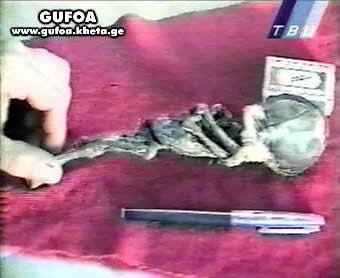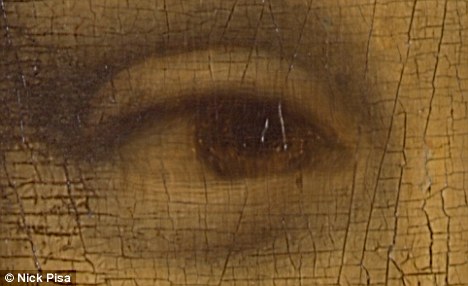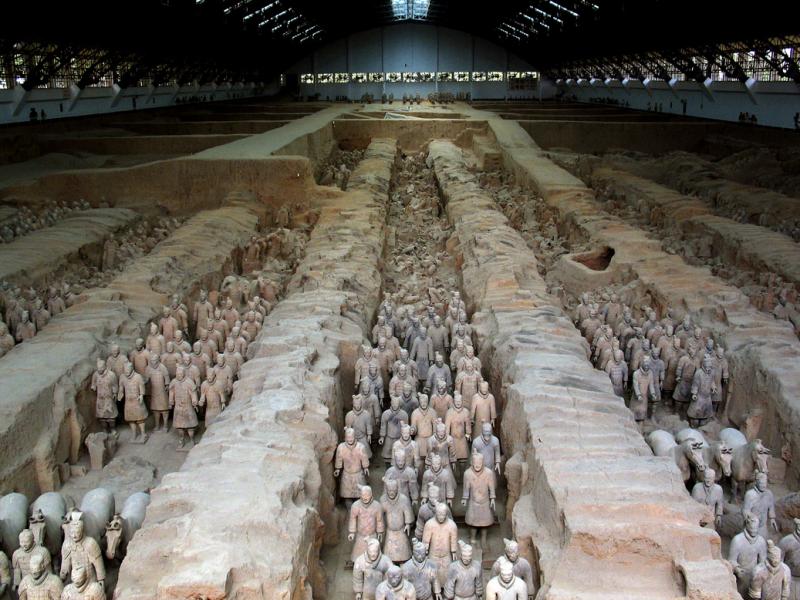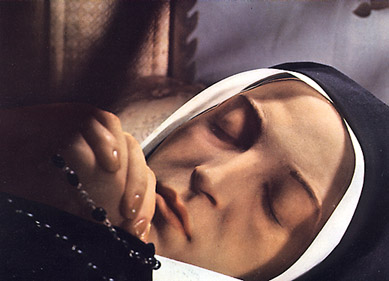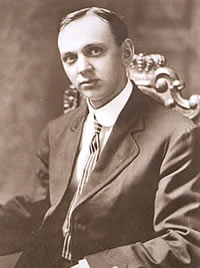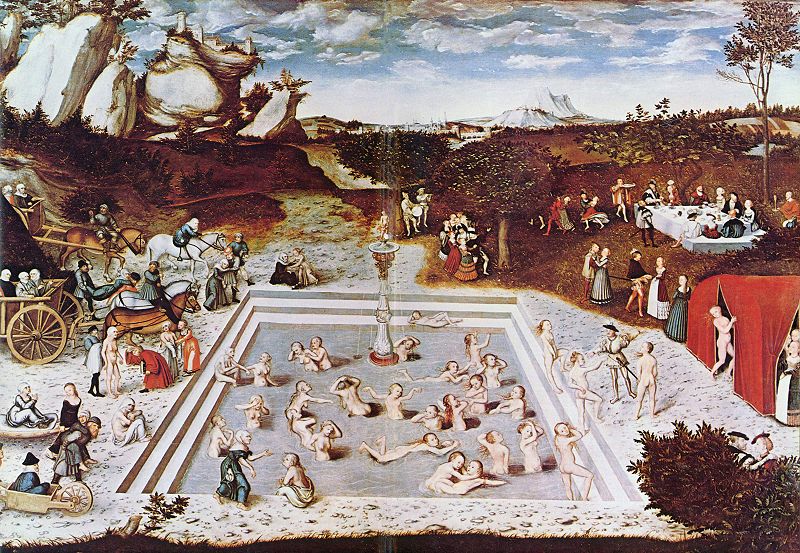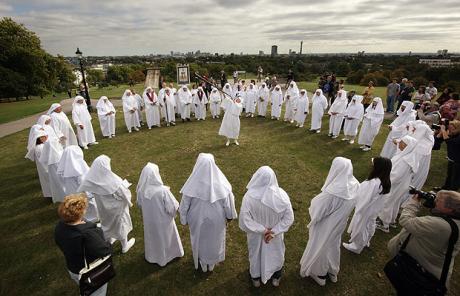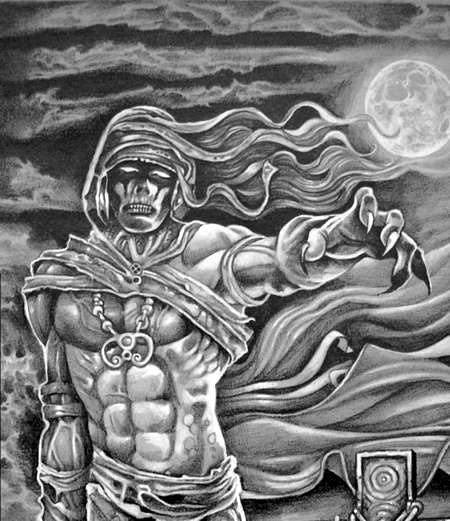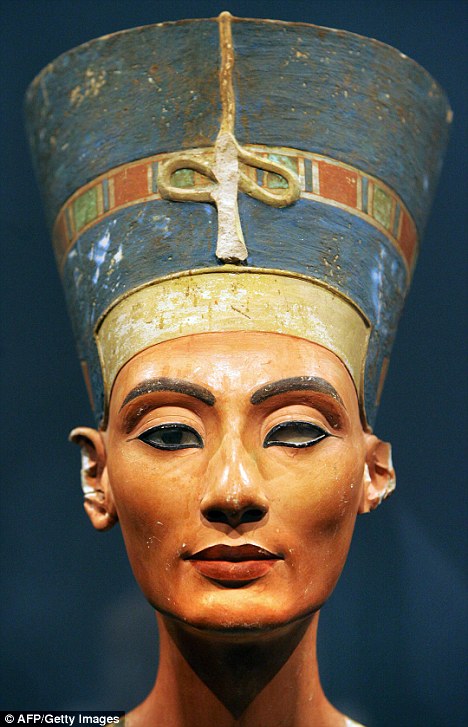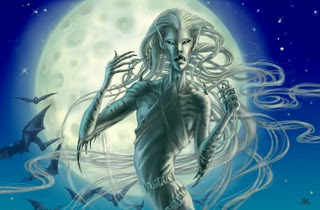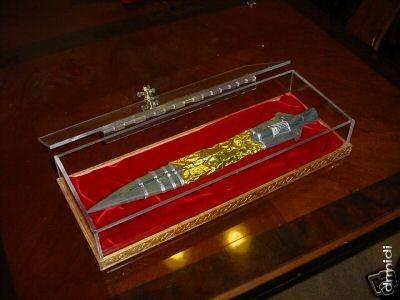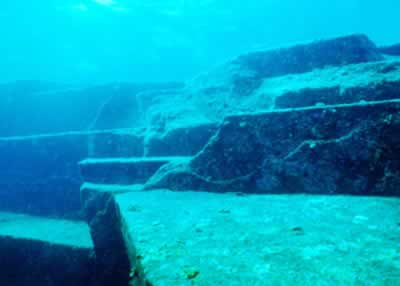Mysterious dwarfish alien brutally murdered in Russia's remote village
Researchers looking into the case of “Alionshenka the Alien” have arrived at a sensational conclusion: the mysterious creature did not catch his death of cold as previously thought. They believe the supposed alien was killed.
“He didn’t die from natural causes,” said Vadim Chernobrov, a coordinator with the public research center Kosmopoisk. “We found out that his skull had been fractured,” Chernobrov added.
The mysterious dwarf was found near the town of Kyshtym of the Chelyabinsk region. Stanislav Samoshkin is a morbid anatomist who performed autopsy on the body of the dwarf in a local hospital. He was the first to claim that the creature was a non-human being.
“The human skull consists of six bones. The skull of that creature was made up of four bones,” Samoshkin said.
Russian and foreign researchers have been trying to unravel the mystery of the “Uralian alien” for eleven years. The story looks like a detective novel in progress. The body of the dwarf was reportedly stolen. The key witness to the case, an old woman who actually named the dwarf “Alioshenka”, died a sudden death.
Researchers believe that Tamara’s account is a true story. She has been repeating it word by word for years without adding up any new details.
“He was giving off that smell, you know, one of a kind. You can’t take it for any other smell. Actually, the smell was pretty agreeable yet somewhat nauseous at the same time. And he didn’t pass any liquid or solid waste matter. He was sweating, and that was all. I saw the mother-in-law wipe the sweat off his face with a rag,” Tamara added.
The old woman died in a hit-and-run accident in August 1999. She was knocked down by a car just a few days before a team of researchers arrived in the town from Moscow. Researchers phoned her relatives shortly before the accident occured. Academician Mark Milkhiker was going to put Prosvirina in a state of hypnosis, a method used for helping the patient recover information buried in his subconscious.
Prosvirina’s relatives are confident that the death of the old woman was not an accident.
“You can hardly see a vehicle crossing this town during the day. Where the hell did that car come from?” Tamara asked.
Read more at Alionshenka-the-Alien - Russian 'Kyshtym' Alien
Wednesday, December 22, 2010
Monday, December 13, 2010
Mona Lisa's Eyes Reveal Code
Art detectives have discovered tiny letters and numbers placed in the eyes of the Mona Lisa.
Like something out of Dan Brown's Da Vinci Code the tiny letters have been identified for the first time under magnification, in the right eye the letters spell out Da Vinci's own initials LV suggesting that he placed them there deliberately.
Intrigue is usually focused on her enigmatic smile.
But the Mona Lisa was at the centre of a new mystery yesterday after art detectives took a fresh look at the masterpiece – and noticed something in her eyes.
Hidden in the dark paint of her pupils are tiny letters and numbers, placed there by the artist Leonardo da Vinci and revealed only now thanks to high-magnification techniques.
Experts say the barely distinguishable letters and numbers represent something of a real-life Da Vinci code.
The revelation could have come straight from the pages of Dan Brown’s best-seller The Da Vinci Code, in which the Mona Lisa is said to contain hidden clues about the Holy Grail.
Silvano Vinceti, president of Italy’s National Committee for Cultural Heritage, which spotted the symbols, said: ‘To the naked eye the symbols are not visible but with a magnifying glass they can clearly be seen.
‘In the right eye appear to be the letters LV which could well stand for his name, Leonardo da Vinci, while in the left eye there are also symbols but they are not as defined.
‘It is very difficult to make them out clearly but they appear to be the letters CE, or it could be the letter B.
‘In the arch of the bridge in the background the number 72 can be seen or it could be an L and the number 2.
‘You have to remember the picture is almost 500 years old so it is not as sharp and clear as when first painted.
‘From the preliminary investigations we have carried out we are confident they are not a mistake and were put there by the artist.
Read more at Mona Lisa Mystery
Like something out of Dan Brown's Da Vinci Code the tiny letters have been identified for the first time under magnification, in the right eye the letters spell out Da Vinci's own initials LV suggesting that he placed them there deliberately.
Intrigue is usually focused on her enigmatic smile.
But the Mona Lisa was at the centre of a new mystery yesterday after art detectives took a fresh look at the masterpiece – and noticed something in her eyes.
Hidden in the dark paint of her pupils are tiny letters and numbers, placed there by the artist Leonardo da Vinci and revealed only now thanks to high-magnification techniques.
Experts say the barely distinguishable letters and numbers represent something of a real-life Da Vinci code.
The revelation could have come straight from the pages of Dan Brown’s best-seller The Da Vinci Code, in which the Mona Lisa is said to contain hidden clues about the Holy Grail.
Silvano Vinceti, president of Italy’s National Committee for Cultural Heritage, which spotted the symbols, said: ‘To the naked eye the symbols are not visible but with a magnifying glass they can clearly be seen.
‘In the right eye appear to be the letters LV which could well stand for his name, Leonardo da Vinci, while in the left eye there are also symbols but they are not as defined.
‘It is very difficult to make them out clearly but they appear to be the letters CE, or it could be the letter B.
‘In the arch of the bridge in the background the number 72 can be seen or it could be an L and the number 2.
‘You have to remember the picture is almost 500 years old so it is not as sharp and clear as when first painted.
‘From the preliminary investigations we have carried out we are confident they are not a mistake and were put there by the artist.
Read more at Mona Lisa Mystery
The Underground Army of Terracotta Warriors
An old Chinese saying says, “treat death as life.” In China, rulers took this saying very seriously. After death they were buried with lavish supplies of dishes, food, silk and musical instruments. In earlier times living things such as wives, servants, or pets were also buried with the Emperor, often still alive. The afterlife was so important to people because it was believed to be a prolongation of life. Everything that was buried in the tomb was thought to be a necessity for one who wanted to be prepared for a grand afterlife. In Lintong County, thirty-five kilometers east of the Chinese city Xi’an, a tomb was found that contained a whole army, armed and ready for battle. This army was created for burial complex of the first Emperor of China, Emperor Qin Shihuang .
Qin Shihuang was the first emperor of the Qin dynasty. He was known as a great leader and a conqueror of many lands. He was a destroyer, a builder, and an unforgiving tyrant. Qin Shihuang's accomplishments turned China into a great empire. He formed a centralized government, standardized the Chinese currency and script, and set up a code of laws. He also uniformed the system of measures and built many roads. One of his greatest accomplishments is considered to be constructing and building one half of what today is the Great Wall of China. While the pits with Qin Shihuangs imperial army has been dug up, the actual tomb has not. The supposed contents of the mausoleum are by the tellings of the grand historian, Sima Qian.
In his historical records dated 1 B.C Sima Qian described how the tomb was made and what was put inside it. A project to uncover the tomb though, was started a few years ago but because of a lack of funds, it came to a screeching halt. Yuan Zhongyi is the head of a small group of archaeologists working on the site of the tomb. So far, only a fifth of the fifty-one square mile tomb has been uncovered. Scientific know-how and reliable technology are scarce making it even harder to fund the excavation of the mausoleum.
Many perishable items such as silk and wood have remained inside the tomb for almost two thousand years. The tomb would answer many questions formed by the mysterious terra-cotta army. The army was actually not meant to be seen. It was made to be a “spirit army” and was not intended for display. Inside the pits it was noticed that all the figures face east. They were thought to be this way because Qin had many armies in the east that he had conquered and could have been suspicious of them. He would have wanted to be ready for battle, even in death. All the pits put together represent Qin Shihaung’s actual imperial guards that were stationed at the east of the capitol. The layout of the soldiers and horses were a replica of what Qin’s Imperial army looked like during his reign from 221—210 BC.
The first pit is thought to be the right-wing infantry division. The second was the left-wing cavalry division. Pit number three was the command unit and the fourth pit was thought to be the central force. The first life-size terra-cotta figure was discovered in the 1920’s. A Chinese peasant was digging a well and came upon it. The water disappeared suddenly from the well and the peasant, thinking this was a sign of evil, quickly re-covered what he had dug. The soldier, once again, was buried. It wasn't found again until the 1970’s when archeologists dug up what was soon to be the first actual pit discovered.
The first pit was discovered in 1974. It is the largest of the four pits and covers almost four acres. It is five meters deep and contains eleven parallel corridors and nine access ramps on the sides . There are nearly 6,000 military men inside the first pit. They make up all parts of the army such as bowmen, archers, charioteers, men with arms, and men without arms. They stand in a contemporary military formation made up of 4 parts; the vanguard, the main force, the outer flanks, and the rear guard. The main force contains six horse-drawn wooden chariots with charioteers. Horses that are about 1.5 meters high and 2 meters long lead these chariots. Over the first pit is the exhibition hall of the museum for Qin Shihuang’s terra-cotta warriors. It is about 230 meters long and has a roof made of glass to allow the sunlight to illuminate the army and horses.
Read more at Unsolved Mysteries of Terracotta Warriors
Tuesday, December 7, 2010
The Incorruptibles
Incorruptibility is a Roman Catholic belief that supernatural intervention allows some human bodies to avoid the normal process of decomposition after death. Bodies that reportedly undergo little or no decomposition, or delayed decomposition, and are sometimes referred to as incorrupt or incorruptible or as an incorruptible. Although it is recognised as supernatural in Roman Catholicism, it is no longer counted as a miracle in the recognition of a saint.
Incorruptibility is seen as distinct from the good preservation of a body, or mummification. Incorruptible bodies are often said to have the odour of sanctity, exuding a sweet or floral, pleasant aroma. As of yet, none of these cases has been verified scientifically.
Incorruptibles are the bodies of saints that miraculously do not decay -- even after decades or even a century or more. The bodies often lie in public view in churches and shrines. Saints include: St. Clare of Assisi, St. Vincent De Paul, St. Bernadette Soubirous, St. John Bosco, Blessed Imelda Lambertini, St. Catherine Labouré, and many others. Even the body of Pope John XXIII is reputed to be remarkable well preserved. The case of Blessed Margaret of Metola is recounted in the Fortean Times article, Saints Preserve Us: "She died in 1330, but in 1558 her remains had to be transferred because her coffin was rotting away. Witnesses were amazed to find that like the coffin, the clothes had rotted, but Margaret's crippled body hadn't."
1. Saint Bernadette of Lourdes, Died 1879
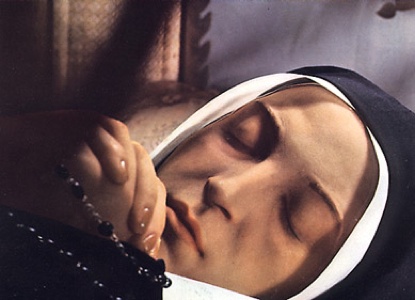
St Bernadette was born Bernadette Soubirous in Lourdes, France. From February to July 1858, she reported eighteen apparitions of “a Lady.” Despite initial skepticism from the Roman Catholic Church, these claims were eventually declared to be worthy of belief after a canonical investigation. After her death, Bernadette’s body remained “incorruptible”, and the shrine at Lourdes went on to become a major site for pilgrimage, attracting millions of Catholics each year.
2. Saint John Vianney, Died 1859
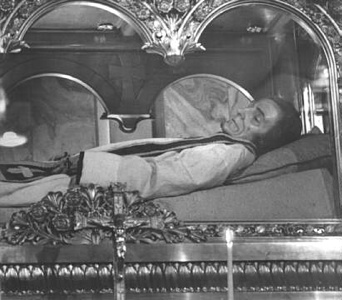
St. Jean Baptiste Marie Vianney (May 8, 1786 – August 4, 1859) was a French parish priest who became a Catholic saint and the patron saint of parish priests. He is often referred to, even in English, as the “Curé d’Ars” (the parish priest of the village of Ars). He became famous internationally for his priestly and pastoral work in his parish due to the radical spiritual transformation of the community and its surroundings.
3. Saint Teresa Margaret, Died 1770
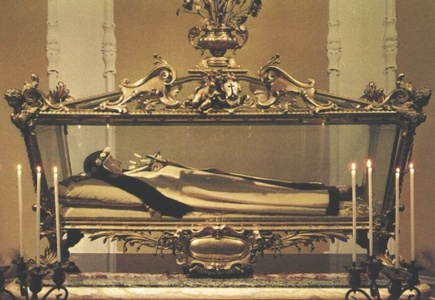
In March 19, 1934, Pope Pius XI entered Blessed Teresa Margaret of the Sacred Heart in the register of saints. In Germany, the new saint is virtually unknown outside of the Carmelite Order. Her life was quiet and hidden. She died on March 7, 1770 at the age of 22, and of this short lifespan, she spent five years in the Carmelite monastery in Florence. She performed no brilliant, attention-getting deeds, nor did her reputation reach the wider world. She spent her life living quietly and with virtue.
Read more on The Incorruptible Saints
Incorruptibility is seen as distinct from the good preservation of a body, or mummification. Incorruptible bodies are often said to have the odour of sanctity, exuding a sweet or floral, pleasant aroma. As of yet, none of these cases has been verified scientifically.
Incorruptibles are the bodies of saints that miraculously do not decay -- even after decades or even a century or more. The bodies often lie in public view in churches and shrines. Saints include: St. Clare of Assisi, St. Vincent De Paul, St. Bernadette Soubirous, St. John Bosco, Blessed Imelda Lambertini, St. Catherine Labouré, and many others. Even the body of Pope John XXIII is reputed to be remarkable well preserved. The case of Blessed Margaret of Metola is recounted in the Fortean Times article, Saints Preserve Us: "She died in 1330, but in 1558 her remains had to be transferred because her coffin was rotting away. Witnesses were amazed to find that like the coffin, the clothes had rotted, but Margaret's crippled body hadn't."
1. Saint Bernadette of Lourdes, Died 1879

St Bernadette was born Bernadette Soubirous in Lourdes, France. From February to July 1858, she reported eighteen apparitions of “a Lady.” Despite initial skepticism from the Roman Catholic Church, these claims were eventually declared to be worthy of belief after a canonical investigation. After her death, Bernadette’s body remained “incorruptible”, and the shrine at Lourdes went on to become a major site for pilgrimage, attracting millions of Catholics each year.
2. Saint John Vianney, Died 1859

St. Jean Baptiste Marie Vianney (May 8, 1786 – August 4, 1859) was a French parish priest who became a Catholic saint and the patron saint of parish priests. He is often referred to, even in English, as the “Curé d’Ars” (the parish priest of the village of Ars). He became famous internationally for his priestly and pastoral work in his parish due to the radical spiritual transformation of the community and its surroundings.
3. Saint Teresa Margaret, Died 1770

In March 19, 1934, Pope Pius XI entered Blessed Teresa Margaret of the Sacred Heart in the register of saints. In Germany, the new saint is virtually unknown outside of the Carmelite Order. Her life was quiet and hidden. She died on March 7, 1770 at the age of 22, and of this short lifespan, she spent five years in the Carmelite monastery in Florence. She performed no brilliant, attention-getting deeds, nor did her reputation reach the wider world. She spent her life living quietly and with virtue.
Read more on The Incorruptible Saints
Monday, December 6, 2010
Hidden Shambhala Mountains
For thousands of years rumors and reports have circulated that somewhere beyond Tibet, among the icy peaks and secluded valleys of Central Asia, there lies an inaccessible paradise, a place of universal wisdom and ineffable peace called Shambhala. Legends say that only the pure of heart can live in Shambhala, enjoying perfect ease and happiness and never knowing suffering, want or old age. Love and wisdom reign and injustice is unknown. The inhabitants are long-lived, wear beautiful and perfect bodies and possess supernatural powers; their spiritual knowledge is deep, their technological level highly advanced, their laws mild and their study of the arts and sciences covers the full spectrum of cultural achievement, but on a far higher level than anything the outside world has attained. By definition Shambhala is hidden. Of the numerous explorers and seekers of spiritual wisdom who attempt to locate Shambhala, none can pinpoint its physical location on a map, although all say it exists in the mountainous regions of Eurasia. Many have also returned believing that Shambhala lies on the very edge of physical reality, as a bridge connecting this world to one beyond it.
In Tibetan Buddhist tradition, Shambhala (also spelled Shambala or Shamballa; Tibetan: bde 'byung, pron. De-jung) is a mythical kingdom hidden somewhere in Inner Asia. It is mentioned in various ancient texts, including the Kalachakra Tantra and the ancient texts of the Zhang Zhung culture which predated Tibetan Buddhism in western Tibet. The Bön scriptures speak of a closely related land called Olmolungring. Whatever its historical basis, Shambhala gradually came to be seen as a Buddhist Pure Land, a fabulous kingdom whose reality is visionary or spiritual as much as physical or geographic. It was in this form that the Shambhala myth reached the West, where it influenced non-Buddhist as well as Buddhist spiritual seekers--and to some extent, popular culture in general. The Sanskrit name means “place of peace, of tranquility.” Though it’s true location has never been found, its beginnings are unknown and its existence is unproven, Shambhala is recognized and honored by at least eight major religions, and is regarded by most esoteric traditions as the true center of the planet and the world’s spiritual powerhouse.
It is said to be inhabited by adepts from every race and culture who form an inner circle that secretly guides human evolution. This remarkable kingdom reputedly exists both above and below ground, with a network of tunnels hundreds of miles long. “Cars of strange design flash along their length,” writes Andrew Tomas, author of Shambhala, Oasis of Light, “and they are illumined by a brilliant, artificial light which affords growth to the grains and vegetables and long life without disease to the people.”
Victoria LePage writes in her superbly researched book, Shambhala: “Modern society is in desperate need of a zone of order, a mandalic center within spiraling chaos.” And she maintains, the quest for this center leads us directly to Shambhala, which she calls “The World Axis.” LePage, who has been studying Shambhala for nearly fifty years, says that many marvels are supposed to have been seen in this underground world: museums, libraries, stores of jewels, and technological inventions thousands of years before their time. And, according to Chinese lore, the aircraft and space vehicles of the Immortals of Shambhala journey among the stars, observing the habitats of other races and kingdoms. It would be easy to dismiss Shambhala as pure mythical fantasy, were it not for a very credible explorer who searched for, found and returned to tell us something about his experiences in Shambhala.
Read more on Shambhala Mountains
In Tibetan Buddhist tradition, Shambhala (also spelled Shambala or Shamballa; Tibetan: bde 'byung, pron. De-jung) is a mythical kingdom hidden somewhere in Inner Asia. It is mentioned in various ancient texts, including the Kalachakra Tantra and the ancient texts of the Zhang Zhung culture which predated Tibetan Buddhism in western Tibet. The Bön scriptures speak of a closely related land called Olmolungring. Whatever its historical basis, Shambhala gradually came to be seen as a Buddhist Pure Land, a fabulous kingdom whose reality is visionary or spiritual as much as physical or geographic. It was in this form that the Shambhala myth reached the West, where it influenced non-Buddhist as well as Buddhist spiritual seekers--and to some extent, popular culture in general. The Sanskrit name means “place of peace, of tranquility.” Though it’s true location has never been found, its beginnings are unknown and its existence is unproven, Shambhala is recognized and honored by at least eight major religions, and is regarded by most esoteric traditions as the true center of the planet and the world’s spiritual powerhouse.
It is said to be inhabited by adepts from every race and culture who form an inner circle that secretly guides human evolution. This remarkable kingdom reputedly exists both above and below ground, with a network of tunnels hundreds of miles long. “Cars of strange design flash along their length,” writes Andrew Tomas, author of Shambhala, Oasis of Light, “and they are illumined by a brilliant, artificial light which affords growth to the grains and vegetables and long life without disease to the people.”
Victoria LePage writes in her superbly researched book, Shambhala: “Modern society is in desperate need of a zone of order, a mandalic center within spiraling chaos.” And she maintains, the quest for this center leads us directly to Shambhala, which she calls “The World Axis.” LePage, who has been studying Shambhala for nearly fifty years, says that many marvels are supposed to have been seen in this underground world: museums, libraries, stores of jewels, and technological inventions thousands of years before their time. And, according to Chinese lore, the aircraft and space vehicles of the Immortals of Shambhala journey among the stars, observing the habitats of other races and kingdoms. It would be easy to dismiss Shambhala as pure mythical fantasy, were it not for a very credible explorer who searched for, found and returned to tell us something about his experiences in Shambhala.
Read more on Shambhala Mountains
The Sleeping Prophet
Born in Kentucky 1877, Edgar Cayce was known as “the Sleeping Prophet,” because he uttered predictions and medical cures while in a deep trance. Until his death in Virginia, 68 years later, Cayce dictated thousands of “life-readings” he allegedly obtained from a kind of spiritual record he claimed to be able to read while experiencing an altered state of consciousness. Until his 47th year, he never uttered a word about Atlantis. But in 1922, he suddenly began recalling life in a place with which he was otherwise allegedly unfamiliar. Cayce said that his trance statements should be taken into account only to the extent that they led to a better life for the recipient. Moreover, he invited his audience to test his suggestions rather than accept them on faith. Other abilities that have been attributed to Cayce include astral projection, prophesying, mediumship, viewing the Akashic Records or "Book of Life", and seeing auras. Cayce said he became interested in learning more about these subjects after he was informed about the content of his readings, which he reported that he never actually heard himself.
Cayce’s descriptions of the doomed civilization are sometimes remarkable for their uncanny credibility. For example, his portrayal of the migration of Atlanteans into the Nile Valley following the destruction of their Empire is entirely convincing. Many otherwise obscure names of persons and places he associates with the Atlantis experience likewise seem to reflect real events. His son, Hugh Lynn Cayce, knew his father “did not read material on Atlantis, and that he, so far as we know, had absolutely no knowledge of the subject.” The evocative, often verifiable detail of his readings in which Atlantis was described is all the more astounding when we realize he knew little about the vanished culture in his waking hours. As his son wrote: They are the most fantastic, the most bizarre, the most impossible information in the Edgar Cayce files. If his unconscious fabricated this material or wove it together from existing legends and writings, we believe that it is the most amazing example of a telepathic-clairvoyant scanning of existing legends and stories in print or of the minds of persons dealing with the Atlantis theory.
Edgar Cayce’s conscious ignorance of the sunken civilization is not surprising. His formal education was meager, and his points of reference were more spiritual than historical or academic. His grasp of the past was often biblical, rather than scholastic. It seems clear then, that the subject was outside the purview of both his background and essentially Christian view of the world. But his readings are selfevidently plausible, because they often contain information that made little or no sense at the time they were uttered, but have been since confirmed by subsequent verification.
Perhaps most impressive of all is that obscure, even fleeting, references he made to Atlantis during the early 1920s were occasionally repeated only once, but within an exact same frame of reference, after more than two decades. Persuasive as these give even skeptics pause, and encourage many investigators, regardless of their spiritual beliefs, to reconsider everything he had to say about Atlantis. His prediction of finding its first physical remains not far from the United States was a case in point described in the “Bimini” entry. Until Cayce spoke of Bimini, and even long after some of his “life-readings” were published, no researchers bothered to consider that small island as a possible remnant of Atlantean Civilization. But how did the massive stone structure come to lie at the bottom of the sea? According to Cayce’s “life-readings,” the Atlantean lands underwent three major periods of inundation. They did not disappear altogether in a single cataclysm. The natural disaster described by Plato represented only the final destruction of Atlantis.
Read more on The Sleeping Prophet
Cayce’s descriptions of the doomed civilization are sometimes remarkable for their uncanny credibility. For example, his portrayal of the migration of Atlanteans into the Nile Valley following the destruction of their Empire is entirely convincing. Many otherwise obscure names of persons and places he associates with the Atlantis experience likewise seem to reflect real events. His son, Hugh Lynn Cayce, knew his father “did not read material on Atlantis, and that he, so far as we know, had absolutely no knowledge of the subject.” The evocative, often verifiable detail of his readings in which Atlantis was described is all the more astounding when we realize he knew little about the vanished culture in his waking hours. As his son wrote: They are the most fantastic, the most bizarre, the most impossible information in the Edgar Cayce files. If his unconscious fabricated this material or wove it together from existing legends and writings, we believe that it is the most amazing example of a telepathic-clairvoyant scanning of existing legends and stories in print or of the minds of persons dealing with the Atlantis theory.
Edgar Cayce’s conscious ignorance of the sunken civilization is not surprising. His formal education was meager, and his points of reference were more spiritual than historical or academic. His grasp of the past was often biblical, rather than scholastic. It seems clear then, that the subject was outside the purview of both his background and essentially Christian view of the world. But his readings are selfevidently plausible, because they often contain information that made little or no sense at the time they were uttered, but have been since confirmed by subsequent verification.
Perhaps most impressive of all is that obscure, even fleeting, references he made to Atlantis during the early 1920s were occasionally repeated only once, but within an exact same frame of reference, after more than two decades. Persuasive as these give even skeptics pause, and encourage many investigators, regardless of their spiritual beliefs, to reconsider everything he had to say about Atlantis. His prediction of finding its first physical remains not far from the United States was a case in point described in the “Bimini” entry. Until Cayce spoke of Bimini, and even long after some of his “life-readings” were published, no researchers bothered to consider that small island as a possible remnant of Atlantean Civilization. But how did the massive stone structure come to lie at the bottom of the sea? According to Cayce’s “life-readings,” the Atlantean lands underwent three major periods of inundation. They did not disappear altogether in a single cataclysm. The natural disaster described by Plato represented only the final destruction of Atlantis.
Read more on The Sleeping Prophet
Tuesday, November 9, 2010
The Cursed Diamond (Hope Diamond)
The Hope diamond has intrigued people for centuries. Its perfect quality, its large size 45.52 carats (9.10 g), and its rare color (fancy deep blue diamond) make it strikingly unique and beautiful, currently housed in the Smithsonian Natural History Museum in Washington, D.C. The Hope Diamond is blue to the naked eye because of trace amounts of boron within its crystal structure, but it exhibits red phosphorescence under ultraviolet light. It is classified as a type IIb diamond, which are semiconductive and usually phosphoresce. The Hope diamond phosphoresces a strong red color, which will last for several seconds after exposure to short wave ultra-violet light. The first known precursor to the Hope Diamond was the Tavernier Blue diamond, a crudely cut triangular shaped stone of 115 carats (22.44 g) (This diamond was much larger than the present weight of the Hope diamond because the Hope has been cut down at least twice in the past three centuries.) The diamond is believed to have come from the Kollur mine in Golconda, India, and is famous for supposedly being cursed.
The Tavernier Blue named for the French merchant-traveler Jean-Baptiste Tavernier who brought it to Europe. His book, the Six Voyages (Le Six Voyages de...), contains sketches of several large diamonds he sold to Louis XIV in 1669; while the blue diamond is shown among these, Tavernier makes no direct statements about when and where he obtained the stone.
The historian Richard Kurin builds a plausible case for 1653 as the year of acquisition, and an origin from the Kollur mine in Guntur district Andhra Pradesh (a part of the Golconda kingdom), India. The history of the stone which was eventually named the Hope diamond began when Tavernier obtained the blue diamond during one of his five voyages to India between the years 1640 and 1667. While there, he stole a large blue diamond from the forehead (or eye) of a statue of the Hindu goddess Sita, the wife of Rama, the Sixth Avatar of Vishnu. Where it had been set as one of two matching eyes, and the temple priests then laid a curse on whoever might possess the missing stone.
Early in the year 1669, Tavernier sold this blue diamond along with approximately one thousand other diamonds to King Louis XIV of France for 220,000 livres, the equivalent of 147 kilograms of pure gold. There has been some controversy regarding the actual weight of the stone; Morel believes that the 112 3/16 carats stated in Tavernier's invoice would be in old French carats, thus 115.28 metric carats. For this transgression, according to the legend, Tavernier was torn apart by wild dogs on a trip to Russia (after he had sold the diamond).
This was the first horrible death attributed to the curse, but the historical record shows that he actually lived to the age of 84 (it is not known how he died).
In 1678, Louis XIV commissioned the court jeweller, Sieur Pitau, to recut the Tavernier Blue, resulting in a 67 1/8 carat (13.4 g) stone which royal inventories thereafter listed as the Blue Diamond of the Crown (diamant bleu de la Couronne de France,), but later English-speaking historians have simply called it the French Blue. It was set in gold and suspended on a neck ribbon for the King to wear on ceremonial occasions.
Read more on Unsolved Mystery of Hope Diamond (Cursed Diamond)
The Tavernier Blue named for the French merchant-traveler Jean-Baptiste Tavernier who brought it to Europe. His book, the Six Voyages (Le Six Voyages de...), contains sketches of several large diamonds he sold to Louis XIV in 1669; while the blue diamond is shown among these, Tavernier makes no direct statements about when and where he obtained the stone.
The historian Richard Kurin builds a plausible case for 1653 as the year of acquisition, and an origin from the Kollur mine in Guntur district Andhra Pradesh (a part of the Golconda kingdom), India. The history of the stone which was eventually named the Hope diamond began when Tavernier obtained the blue diamond during one of his five voyages to India between the years 1640 and 1667. While there, he stole a large blue diamond from the forehead (or eye) of a statue of the Hindu goddess Sita, the wife of Rama, the Sixth Avatar of Vishnu. Where it had been set as one of two matching eyes, and the temple priests then laid a curse on whoever might possess the missing stone.
Early in the year 1669, Tavernier sold this blue diamond along with approximately one thousand other diamonds to King Louis XIV of France for 220,000 livres, the equivalent of 147 kilograms of pure gold. There has been some controversy regarding the actual weight of the stone; Morel believes that the 112 3/16 carats stated in Tavernier's invoice would be in old French carats, thus 115.28 metric carats. For this transgression, according to the legend, Tavernier was torn apart by wild dogs on a trip to Russia (after he had sold the diamond).
This was the first horrible death attributed to the curse, but the historical record shows that he actually lived to the age of 84 (it is not known how he died).
In 1678, Louis XIV commissioned the court jeweller, Sieur Pitau, to recut the Tavernier Blue, resulting in a 67 1/8 carat (13.4 g) stone which royal inventories thereafter listed as the Blue Diamond of the Crown (diamant bleu de la Couronne de France,), but later English-speaking historians have simply called it the French Blue. It was set in gold and suspended on a neck ribbon for the King to wear on ceremonial occasions.
Read more on Unsolved Mystery of Hope Diamond (Cursed Diamond)
Fountain of Youth
The Fountain of Youth is a legendary spring that reputedly restores the youth of anyone who drinks of its waters. Florida is often said to be its location, and stories of the fountain are some of the most persistent associated with the state.
A long-standing story is that Spanish explorer Juan Ponce de León, Puerto Rico's first Governor, was searching for the Fountain of Youth when he traveled to present-day Florida in 1513, but the story did not start with him, nor was it unique to the New World. Tales of healing waters date to at least the time of the Alexander Romance, and were popular right up to the European Age of Exploration. The later legend derives from the "Water of Life" tale in the Eastern versions of the Alexander Romance, where Alexander and his servant cross the Land of Darkness to find the restorative spring. The servant in that story is in turn derived from Middle Eastern legends of Al-Khidr, a sage who appears also in the Qur'an. Arabic and Aljamiado versions of the Alexander Romance were very popular in Spain during and after the period of Moorish rule, and would have been known to the explorers who journeyed to America.
There are countless indirect sources for the tale as well. Eternal youth is a gift frequently sought in myth and legend, and stories of things such as the philosopher's stone, universal panaceas, and the elixir of life are common throughout Eurasia and elsewhere. An additional hint may have been taken from the account of the Pool of Bethesda in the Gospel of John, in which Jesus heals a man at the pool in Jerusalem.
The Arawaks and the land of Bimini
The native stories about the curative spring were related to the mythical land of "Beimeni", or Beniny, a land of wealth and prosperity. The spring was purportedly located on an island called Boinca. Although subsequent interpretations suggested the land was located in the vicinity of the Bahamas, the natives were referring to a location in the Gulf of Honduras.
The islands of Bimini in the Bahamas were known as La Vieja during the Ponce expedition. According to legend, the Spanish heard of Bimini from the Arawaks in Hispaniola, Cuba, and Puerto Rico. Sequene, an Arawak chief from Cuba, had purportedly been unable to resist the lure of Bimini and its restorative fountain. He gathered a troupe of adventurers and sailed north, never to return. Word spread among Sequene's more optimistic tribesmen that he and his followers had located the Fountain of Youth and were living in luxury in Bimini. Bimini and its curative waters were widespread subjects in the Caribbean. Italian-born chronicler Peter Martyr d'Anghiera (Peter Martyr) told of them in a letter to the pope in 1513, though he didn't believe the stories and was dismayed that so many others did.
Read more about Fountain of Youth
A long-standing story is that Spanish explorer Juan Ponce de León, Puerto Rico's first Governor, was searching for the Fountain of Youth when he traveled to present-day Florida in 1513, but the story did not start with him, nor was it unique to the New World. Tales of healing waters date to at least the time of the Alexander Romance, and were popular right up to the European Age of Exploration. The later legend derives from the "Water of Life" tale in the Eastern versions of the Alexander Romance, where Alexander and his servant cross the Land of Darkness to find the restorative spring. The servant in that story is in turn derived from Middle Eastern legends of Al-Khidr, a sage who appears also in the Qur'an. Arabic and Aljamiado versions of the Alexander Romance were very popular in Spain during and after the period of Moorish rule, and would have been known to the explorers who journeyed to America.
There are countless indirect sources for the tale as well. Eternal youth is a gift frequently sought in myth and legend, and stories of things such as the philosopher's stone, universal panaceas, and the elixir of life are common throughout Eurasia and elsewhere. An additional hint may have been taken from the account of the Pool of Bethesda in the Gospel of John, in which Jesus heals a man at the pool in Jerusalem.
The Arawaks and the land of Bimini
The native stories about the curative spring were related to the mythical land of "Beimeni", or Beniny, a land of wealth and prosperity. The spring was purportedly located on an island called Boinca. Although subsequent interpretations suggested the land was located in the vicinity of the Bahamas, the natives were referring to a location in the Gulf of Honduras.
The islands of Bimini in the Bahamas were known as La Vieja during the Ponce expedition. According to legend, the Spanish heard of Bimini from the Arawaks in Hispaniola, Cuba, and Puerto Rico. Sequene, an Arawak chief from Cuba, had purportedly been unable to resist the lure of Bimini and its restorative fountain. He gathered a troupe of adventurers and sailed north, never to return. Word spread among Sequene's more optimistic tribesmen that he and his followers had located the Fountain of Youth and were living in luxury in Bimini. Bimini and its curative waters were widespread subjects in the Caribbean. Italian-born chronicler Peter Martyr d'Anghiera (Peter Martyr) told of them in a letter to the pope in 1513, though he didn't believe the stories and was dismayed that so many others did.
Read more about Fountain of Youth
Thursday, November 4, 2010
The Cursed Ring
In the vault of a Los Angeles bank lies a silver ring set with a semiprecious stone. It is not a particularly pretty ring or even a very valuable one, and chances are that no one will ever dare to wear it again. The ring lies in the vault because it bears one of the most malignant curses in the history of the occult. Successive owners have suffered injury, misfortune, even death. And many people still believe it was this ring that sent Rudolph Valentino to a premature grave. Certainly, the violent incidents that have surrounded it over the years can hardly be shrugged off as mere coincidences.
Rudolph Valentino (May 6, 1895 – August 23, 1926) was an Italian actor, sex symbol, and early pop icon. Known as the "Latin Lover", he was one of the most popular stars of the 1920s, and one of the most recognized stars from the silent film era. He is best known for his work in The Sheik and The Four Horsemen of the Apocalypse.
Valentino was born Rodolfo Alfonso Raffaello Piero Filiberto Guglielmi in Castellaneta, Italy, to a French mother, Marie Berthe Gabrielle Barbin (1856 - 1919), and Giovanni Antonio Giuseppe Fidele Guglielmi, a veterinarian who died of malaria, then widespread in Southern Italy, when Valentino was 11. He had an older brother, Alberto (1892-1981), a younger sister, Maria, and an older sister Beatrice who died in infancy.
As a child, Valentino was reportedly spoiled and troublesome. His mother coddled him while his father disapproved of his behavior. He did poorly in school, and was eventually enrolled in agricultural school where he received a degree. After living in Paris in 1912, he soon returned to Italy. Unable to secure employment, he departed for the United States in 1913. He was processed at Ellis Island at age 18 on December 23, 1913.
In 1917, Valentino joined an operetta company that traveled to Utah where it disbanded. He then joined an Al Jolson production of Robinson Crusoe Jr., travelling to Los Angeles. By fall, he was in San Francisco with a bit part in a theatrical production of Nobody Home. While in town, Valentino met actor Norman Kerry, who convinced him to try a career in cinema, still in the silent film era.
By 1919, he had carved out a career in bit parts. It was a bit part as a "cabaret parasite" in the drama The Eyes of Youth that caught the attention of screenwriter June Mathis, who thought he would be perfect for her next movie.
It was in 1920 that Valentino, at the peak of his success, saw the ring in a San Francisco jeweller's. The proprietor warned him that the ring was a jinx, but Valentino still bought it. He wore the ring in his next picture, The Young Rajah. It was the biggest flop of his career and he was off the screen for the next two years. Valentino did not wear the ring again until he used it as a costume prop in The Son of the Sheik. Three weeks after finishing this film, he went to New York on vacation. While wearing the ring, he suffered an acute attack of appendicitis. Two weeks later, he was dead.
Read more at The Cursed Ring
Rudolph Valentino (May 6, 1895 – August 23, 1926) was an Italian actor, sex symbol, and early pop icon. Known as the "Latin Lover", he was one of the most popular stars of the 1920s, and one of the most recognized stars from the silent film era. He is best known for his work in The Sheik and The Four Horsemen of the Apocalypse.
Valentino was born Rodolfo Alfonso Raffaello Piero Filiberto Guglielmi in Castellaneta, Italy, to a French mother, Marie Berthe Gabrielle Barbin (1856 - 1919), and Giovanni Antonio Giuseppe Fidele Guglielmi, a veterinarian who died of malaria, then widespread in Southern Italy, when Valentino was 11. He had an older brother, Alberto (1892-1981), a younger sister, Maria, and an older sister Beatrice who died in infancy.
As a child, Valentino was reportedly spoiled and troublesome. His mother coddled him while his father disapproved of his behavior. He did poorly in school, and was eventually enrolled in agricultural school where he received a degree. After living in Paris in 1912, he soon returned to Italy. Unable to secure employment, he departed for the United States in 1913. He was processed at Ellis Island at age 18 on December 23, 1913.
In 1917, Valentino joined an operetta company that traveled to Utah where it disbanded. He then joined an Al Jolson production of Robinson Crusoe Jr., travelling to Los Angeles. By fall, he was in San Francisco with a bit part in a theatrical production of Nobody Home. While in town, Valentino met actor Norman Kerry, who convinced him to try a career in cinema, still in the silent film era.
By 1919, he had carved out a career in bit parts. It was a bit part as a "cabaret parasite" in the drama The Eyes of Youth that caught the attention of screenwriter June Mathis, who thought he would be perfect for her next movie.
It was in 1920 that Valentino, at the peak of his success, saw the ring in a San Francisco jeweller's. The proprietor warned him that the ring was a jinx, but Valentino still bought it. He wore the ring in his next picture, The Young Rajah. It was the biggest flop of his career and he was off the screen for the next two years. Valentino did not wear the ring again until he used it as a costume prop in The Son of the Sheik. Three weeks after finishing this film, he went to New York on vacation. While wearing the ring, he suffered an acute attack of appendicitis. Two weeks later, he was dead.
Read more at The Cursed Ring
666 - Number of beast Antichrist
The association of the number 666 with the Antichrist is derived from Revelation 13:18 in which John the Revelator is told in his apocalyptic vision that the number of the Beast is 666 and that the number stands for a person. In John’s world of the first century, the Beast that ruled the Earth would have been the emperor, the caesar, of the Roman Empire, Nero (37C.E.–68 C.E.). Using the Hebrew alphabet, the numerical value of “Caesar Nero,” the merciless persecutor of the early Christians, is 666. Although Jesus (c. 6 B.C.E.–c. 30 C.E.) made it clear when speaking to the apostles that no one will know the exact hour or day of his Second Coming, for many centuries certain Christian theologians have associated the rise of the Antichrist to power and his achievement of a seven-year reign over all the
Earth as a kind of catalyst that would set in motion Armageddon, the last final battle between good and evil—the ultimate clash between the armies of Jesus Christ and Satan. Ever since the Protestant Reformation, the pope has been a favorite of certain Evangelicals for the ignominious title. Many of the pontiffs in the Middle Ages did exercise great power over the rulers and the people of the emerging European nations; and consequently, there were numerous embittered princes and fiery Protestant leaders who did seek to affix the blame for a large number of repressive social and religious programs on the Vatican.
However, contemporary popes have wielded little political influence, surely none that would place them in world-threatening positions. There have been such men as Aleister Crowley (1875–1947), who actually appeared to covet and campaign for the position by calling himself the Beast and 666. Hollywood has capitalized on the fascination of certain Christians and horror movie fans with the menacing evil of the Antichrist and depicted him in a number of motion pictures.
In Rosemary’s Baby (1968), an unsuspecting young wife (Mia Farrow) is selected to bear the Antichrist after her husband (John Cassavetes) makes a pact with Satan. The Omen (1976) spawned a series of three films that follow the Antichrist from early childhood to his position of wealth, power, and charismatic mastery as an adult. In the first of these films, Gregory Peck, as the unsuspecting surrogate father of the Antichrist, is warned of his son’s true identity by a number of priests and other individuals who all meet untimely warnings as the babble of the demented, he is later shocked to discover the numerals “666” on his son’s scalp and he resolves to do whatever must be done to stop Satan’s will from being accomplished. In spite of a valiant effort on the part of the father, who now concludes rightfully that his true son was killed and supplanted by the disciples of the Antichrist, the demon seed continues his destructive path to world domination in two additional films.
Read more at http://theunexplainedmysteries.com/666.html
Earth as a kind of catalyst that would set in motion Armageddon, the last final battle between good and evil—the ultimate clash between the armies of Jesus Christ and Satan. Ever since the Protestant Reformation, the pope has been a favorite of certain Evangelicals for the ignominious title. Many of the pontiffs in the Middle Ages did exercise great power over the rulers and the people of the emerging European nations; and consequently, there were numerous embittered princes and fiery Protestant leaders who did seek to affix the blame for a large number of repressive social and religious programs on the Vatican.
However, contemporary popes have wielded little political influence, surely none that would place them in world-threatening positions. There have been such men as Aleister Crowley (1875–1947), who actually appeared to covet and campaign for the position by calling himself the Beast and 666. Hollywood has capitalized on the fascination of certain Christians and horror movie fans with the menacing evil of the Antichrist and depicted him in a number of motion pictures.
In Rosemary’s Baby (1968), an unsuspecting young wife (Mia Farrow) is selected to bear the Antichrist after her husband (John Cassavetes) makes a pact with Satan. The Omen (1976) spawned a series of three films that follow the Antichrist from early childhood to his position of wealth, power, and charismatic mastery as an adult. In the first of these films, Gregory Peck, as the unsuspecting surrogate father of the Antichrist, is warned of his son’s true identity by a number of priests and other individuals who all meet untimely warnings as the babble of the demented, he is later shocked to discover the numerals “666” on his son’s scalp and he resolves to do whatever must be done to stop Satan’s will from being accomplished. In spite of a valiant effort on the part of the father, who now concludes rightfully that his true son was killed and supplanted by the disciples of the Antichrist, the demon seed continues his destructive path to world domination in two additional films.
Read more at http://theunexplainedmysteries.com/666.html
Monday, October 25, 2010
The Haunted History Of Halloween - Video
The Haunted History Of Halloween Video - Part 1
Halloween, celebrated each year on October 31, is a mix of ancient Celtic practices, Catholic and Roman religious rituals and European folk traditions that blended together over time to create the holiday we know today. Straddling the line between fall and winter, plenty and paucity and life and death, Halloween is a time of celebration and superstition. Halloween has long been thought of as a day when the dead can return to the earth, and ancient Celts would light bonfires and wear costumes to ward off these roaming ghosts.Watch the complete Haunted History Of Halloween Video
Friday, October 15, 2010
Halloween Fun Facts and Trivia - 100 Interesting Halloween Facts
Below you'll find some interesting Halloween facts, traditions and other bits of information relating to the history of Halloween. You can always find a way to use these interesting Halloween facts at your party, for instance in a Halloween quiz.
Behind the name "Halloween", or the "Hallow E'en" as they call it in Ireland, means 'All Hallows Eve', or the night before the 'All Hallows', also called 'All Hallowmas', or 'All Saints', or 'All Souls' Day, observed on November 1.
One story says that on Nov. 1 the disembodied spirits of all those who had died throughout the preceding year would come back in search of living bodies to possess for the next year. It was believed to be their only hope for the afterlife. The Celts believed all laws of space and time were suspended during this time, allowing the spirit world to intermingle with the living.
Naturally, the still living did not want to be possessed. So on the night of October 31, villagers would extinguish the fires in their homes, to make them cold and undesirable. They would then dress up in all manner of ghoulish costumes and noisily paraded around the neighborhood, being as destructive as possible in order to frighten away spirits looking for bodies to possess.
Another one of those interesting Halloween facts has to do with the custom of trick-or-treating. This custom is thought to have originated not with the Irish Celts, but with a ninth-century European custom called "souling". On November 2, All Souls Day, early Christians would walk from village to village begging for "soul cakes," made out of square pieces of bread with currants. The more soul cakes the beggars would receive, the more prayers they would promise to say on behalf of the dead relatives of the donors. At the time, it was believed that the dead remained in limbo for a time after death, and that prayer, even by strangers, could expedite a soul's passage to heaven.
Another assumption: On the evening before Samhain (another name for Halloween), people left food on their doorsteps to keep hungry spirits from entering the house. Festivalgoers started dressing in ghost, witch, and goblin costumes so that wandering spirits would leave them alone. To this day, these are Halloween's most popular costumes.
The Irish used turnips as their "Jack's lanterns" originally. But when the immigrants came to America , they found that pumpkins were far more plentiful than turnips. So the Jack-O-Lantern in America was a hollowed-out pumpkin, lit with an ember.
Growing big pumpkins is a big-time and serious hobby. Top prize money for the biggest giant pumpkin is as much as $25,000 dollars at fall festivals. The current world record for giant pumpkins is 1446 pounds (that's a lot of pumpkin pies!).
More interesting Halloween facts have to do with witches. "Witch" comes from the Saxon word wicca which means 'wise one'. Witches were thought to be wise enough to tell the future.
Read more Halloween Fun Facts and Halloween History
Friday, October 8, 2010
Crying Boy Cursed Painting
‘The Curse of the Crying Boy’ appeared out of the blue one morning in 1985. The Sun, at that time the most popular tabloid newspaper in the English-speaking world, published on page 13 of its 4 September edition a story headlined: “Blazing Curse of the Crying Boy”. It told how Ron and May Hall blamed a cheap painting of a toddler with tears rolling down his face for a fire which gutted their terraced council home in Rotherham, a mining town in South Yorkshire. The blaze broke out in a chip-pan in the kitchen of their home of 27 years and spread rapidly. But although the downstairs rooms of the house were badly damaged, the framed print of the Crying Boy escaped unscathed. It continued to hang there, surrounded by a scene of devastation.
Normally a chip-pan blaze would merit nothing more than a couple of paragraphs in a local newspaper. What transformed this story into a page lead in Britain’s leading tabloid was the intervention of Ron Hall’s brother Peter, a firefighter based in Rotherham. A colleague of Peter’s, station officer Alan Wilkinson, said he knew of numerous other cases where prints of the ‘Crying Boy’ had turned up, undamaged, in the ruins of homes destroyed by fires. Accompanying the article was a photograph of a ‘Crying Boy’, with the caption: “Tears for fears… the portrait that firemen claim is cursed.”
The firemen concerned had not actually used the word ‘cursed’, but nevertheless the newspaper report had helped to give the story a certain level of credibility. The paper added that an estimated 50,000 ‘Crying Boy’ prints, signed ‘G Bragolin’, had been sold in branches of British department stores, particularly in the working class areas of northern England. Examples could be seen hanging in the front rooms of family homes across the nation, and one story even suggested a quarter of a million had been sold.
After one month of hearing all the tales, the “Sun” gave their readers the chance to bring their “Crying boy” paintings and agreed to have a very large bon fire to rid everyone of this cursed or jinxed painting. All paintings that were brought to the newspaper were in fact burned and everyone rejoiced. However, the story goes on. There have been reports of the crying boy painting being found in charred homes untouched since 1985 and as recent as 1988.
Typical of these additional stories was that told by Dora Mann, from Mitcham, Surrey, who claimed her house was gutted just six months after she bought a print of the painting. “All my paintings were destroyed – except the one of the Crying Boy,” she claimed. Sandra Kaske, of Kilburn, North Yorkshire, said that she, her sister-in-law, and a friend had all suffered disastrous fires since they acquired copies. Another family, from Nottingham, blamed the print for a blaze which had left them homeless. Brian Parks, whose wife and three children needed treatment for smoke inhalation, said he had destroyed his copy after returning from hospital to find it hanging – undamaged, of course – on the blackened wall of his living room. As the stories accumulated, new details emerged that encouraged the idea that possession of a print put owners at risk of fire or serious injury.
Read more on The Cursed Painting of Crying Boy
Normally a chip-pan blaze would merit nothing more than a couple of paragraphs in a local newspaper. What transformed this story into a page lead in Britain’s leading tabloid was the intervention of Ron Hall’s brother Peter, a firefighter based in Rotherham. A colleague of Peter’s, station officer Alan Wilkinson, said he knew of numerous other cases where prints of the ‘Crying Boy’ had turned up, undamaged, in the ruins of homes destroyed by fires. Accompanying the article was a photograph of a ‘Crying Boy’, with the caption: “Tears for fears… the portrait that firemen claim is cursed.”
The firemen concerned had not actually used the word ‘cursed’, but nevertheless the newspaper report had helped to give the story a certain level of credibility. The paper added that an estimated 50,000 ‘Crying Boy’ prints, signed ‘G Bragolin’, had been sold in branches of British department stores, particularly in the working class areas of northern England. Examples could be seen hanging in the front rooms of family homes across the nation, and one story even suggested a quarter of a million had been sold.
After one month of hearing all the tales, the “Sun” gave their readers the chance to bring their “Crying boy” paintings and agreed to have a very large bon fire to rid everyone of this cursed or jinxed painting. All paintings that were brought to the newspaper were in fact burned and everyone rejoiced. However, the story goes on. There have been reports of the crying boy painting being found in charred homes untouched since 1985 and as recent as 1988.
Typical of these additional stories was that told by Dora Mann, from Mitcham, Surrey, who claimed her house was gutted just six months after she bought a print of the painting. “All my paintings were destroyed – except the one of the Crying Boy,” she claimed. Sandra Kaske, of Kilburn, North Yorkshire, said that she, her sister-in-law, and a friend had all suffered disastrous fires since they acquired copies. Another family, from Nottingham, blamed the print for a blaze which had left them homeless. Brian Parks, whose wife and three children needed treatment for smoke inhalation, said he had destroyed his copy after returning from hospital to find it hanging – undamaged, of course – on the blackened wall of his living room. As the stories accumulated, new details emerged that encouraged the idea that possession of a print put owners at risk of fire or serious injury.
Read more on The Cursed Painting of Crying Boy
The Mysterious Case of Bridey Murphy
In the 1950s hypnotist Morey Bernstein of Pueblo, Colorado, was working with one of his clients, a twenty-nine-year old housewife and mother named Virginia Tighe when, during one of their sessions, she spoke with the voice and memories of a nineteenth-century Irishwoman named Bridey Murphy. The first time this occurred, Bernstein had been trying to help Tighe to remember her childhood and had casually suggested that she “go to some other place in some other time.” He meant for her to remember some other period of her life, but instead she seemed to jump to the life of someone else who had lived long before. In an Irish accent, she told Bernstein that she, Bridey Murphy, had been born in 1798 and died in 1864 of complications from a broken hip. Virginia Tighe herself was born in the Midwest in 1923, had never been to Ireland, and did not speak with even the slightest hint of an Irish accent.
In this and subsequent hypnosis sessions, she also provided Bernstein with numerous details about her family, experiences, likes and dislikes. For example, she gave the name of the Catholic church in Belfast, Ireland, where she had married Sean Brian Joseph McCarthy in 1818 and offered detailed descriptions of places where she had shopped for food. She also told Bernstein about the time in-between lives, when the spirit waited for a new existence. During this period, she said, she could travel anywhere with just a thought.
Her tale began in 1806 when Bridey was eight years old and living in a house in Cork. She was the daughter of Duncan Murphy, a barrister, and his wife Kathleen. At the age of 17 she married lawyer Sean Brian McCarthy and moved to Belfast. Bridey told of a fall that caused her death and of watching her own funeral, describing her tombstone and the state of being in life after death. It was, she recalled, a feeling of neither pain nor happiness. Somehow, she was reborn in America, although Bridey was not clear how this reincarnation happened.
Bernstein tape-recorded each session, and in 1956 he published a book based on his work, "The Search for Bridey Murphy". (Bernstein called Tighe “Ruth Simmons” in his writings in order to protect her anonymity, but journalists soon uncovered her real name.) Skeptics soon began noting flaws in Tighe’s story. Many of her place descriptions, including details about where Murphy had bought her food, were accurate, but other facts were not. The same was true of her language; some of the words she used were appropriate diction for a nineteenth-century Irishwoman, but others were those of a twentieth-century American. In addition, neither skeptics nor believers could find any evidence that anyone named Bridey Murphy had ever lived. Searches of church baptismal records and other records turned up nothing.
Read more on Bridey Murphy Reincarnation case
Monday, October 4, 2010
4000-year-old Aryan city discovered in Russia
Spiral cities built on remote Russian plains by swastika-painting Aryans
Russian archaeologists have unearthed some ancient and virtually unknown settlements which they believe were built by the original Aryan race about 4000 years ago.
According to the team which has discovered 20 of the spiral-shaped settlements in remote part of Russia steppe in southern Siberia bordering Kazakhstan, the buildings date back to the beginning of Western civilisation in Europe.
The Bronze-age settlements, the experts said, could have been built shortly after the Great Pyramid some 4000 years ago by the original Aryan race whose swastika symbol was later adopted by the Nazis in the 1930s.
TV historian Bettany Hughes, who explored the desolate part of the Russian steppe for BBC programme 'Tracking The Aryans', said: "Potentially, this could rival ancient Greece in the age of the heroes."
"Because I have written a lot about the Bronze Age world, there always seemed to be this huge missing piece of the jigsaw puzzle," Hughes was quoted as saying by the Daily Mail.
She said: "We are all told that there is this kind of mother tongue, proto-Indo-European, from which all the languages we know emerge.
"I was very excited to hear on the archaeological grapevine that in exactly the period I am an expert in, this whole new Bronze Age civilisation had been discovered on the steppe of southern Siberia."
The remains of the ancient city were explored for the first time around 20 years ago shortly after then Soviet officials relaxed strict laws banning non-military aerial photography.
But because of the region is so remote the incredible cities have remained virtually unknown to the rest of Europe until now, according to the archaeologists
Read more on this unexplained mystery
Russian archaeologists have unearthed some ancient and virtually unknown settlements which they believe were built by the original Aryan race about 4000 years ago.
According to the team which has discovered 20 of the spiral-shaped settlements in remote part of Russia steppe in southern Siberia bordering Kazakhstan, the buildings date back to the beginning of Western civilisation in Europe.
The Bronze-age settlements, the experts said, could have been built shortly after the Great Pyramid some 4000 years ago by the original Aryan race whose swastika symbol was later adopted by the Nazis in the 1930s.
TV historian Bettany Hughes, who explored the desolate part of the Russian steppe for BBC programme 'Tracking The Aryans', said: "Potentially, this could rival ancient Greece in the age of the heroes."
"Because I have written a lot about the Bronze Age world, there always seemed to be this huge missing piece of the jigsaw puzzle," Hughes was quoted as saying by the Daily Mail.
She said: "We are all told that there is this kind of mother tongue, proto-Indo-European, from which all the languages we know emerge.
"I was very excited to hear on the archaeological grapevine that in exactly the period I am an expert in, this whole new Bronze Age civilisation had been discovered on the steppe of southern Siberia."
The remains of the ancient city were explored for the first time around 20 years ago shortly after then Soviet officials relaxed strict laws banning non-military aerial photography.
But because of the region is so remote the incredible cities have remained virtually unknown to the rest of Europe until now, according to the archaeologists
Read more on this unexplained mystery
Druidry recognised as religion in Britain for first time
The Druid Network has been given charitable status by the Charity Commission for England and Wales, the quango that decides what counts as a genuine faith as well as regulating fundraising bodies.
It guarantees the modern group, set up in 2003, valuable tax breaks but also grants the ancient religion equal status to more mainstream denominations. This could mean that Druids, the priestly caste in Celtic societies across Europe, are categorised separately in official surveys of religious believers.
Supporters say the Charity Commission’s move could also pave the way for other minority faiths to gain charitable status.
Phil Ryder, Chair of Trustees for The Druid Network, said it had taken four years for the group to be recognised by the regulator. “It was a long and at times frustrating process, exacerbated by the fact that the Charity Commissioners had no understanding of our beliefs and practices, and examined us on every aspect of them. Their final decision document runs to 21 pages, showing the extent to which we were questioned in order to finally get the recognition we have long argued for,” he said.
Emma Restall Orr, founder of The Druid Network, added: “The Charity Commission now has a much greater understanding of Pagan, animist, and polytheist religions, so other groups from these minority religions – provided they meet the financial and public benefit criteria for registration as charities - should find registering a much shorter process than the pioneering one we have been through.”
In its assessment of the Druid Network’s application, the Charity Commission accepts that Druids worship nature, in particular the sun and the earth but also believe in the spirits of places such as mountains and rivers as well as “divine guides” such as Brighid and Bran.
The document lists the “commonality of practice” in Druidry, including its eight major festivals each year; rituals at different phases of the moon; rites of passage and gatherings of bards on sacred hills, known as “gorsedd”.
Labels:
Druid,
Druidry,
Druidry religion,
Neo-Druidism,
Neo-Druidry,
unexplained,
unsolved
Tuesday, September 28, 2010
Unsolved Murder Mystery of Black Dahlia and Torso Slayer
She was known as the “Black Dahlia”. She had jet black hair and preferred black dresses and lingerie. Those who knew her best said she had a tattoo of an exotic flower on her inner thigh. She wanted desperately to be a Hollywood actress, but her fame would not come from the movies. It would come from her death, a murder which has gone unsolved for 60 years.
Elizabeth Short(July 29, 1924 – ca. January 15, 1947) was an American woman and the victim of a gruesome and much-publicized murder. She acquired the moniker The Black Dahlia posthumously by newspapers in the habit of nicknaming crimes they found particularly colorful. Short was found mutilated, her body severed at the waist, on January 15, 1947, in Leimert Park, Los Angeles, California. Short's unsolved murder has been the source of widespread speculation along with several books and film adaptations.
On a cold morning in January 1947, the nude, mutilated body of 22-year-old Elizabeth Short was discovered in a vacant lot in the Leimert Park area of Los Angeles. What made the murder so unique was the barbaric nature of the crime. The Black Dahlia’s body had been neatly severed in half, gutted and drained of blood. Author Lawrence P. Scherb put the unusual crime into perspective:
“Her face had been very brutally cut from ear to ear in a grin. Her throat had been cut and she had been mutilated sexually. Basically, she was the worst case of a sex crime in the history of Los Angeles County.”
The case of The Black Dahlia has fascinated crime writers for generations, and almost every one of them has a different theory about the killer. Lawrence Scherb has studied the Black Dahlia case extensively. Now, he believes he knows the identity of the man who so brutally murdered Elizabeth Short.
Elizabeth Short’s life was as sad as it was brief. Like so many other young women, Elizabeth had been lured to Hollywood with dreams of becoming a star. Her career was going nowhere and she was running out of cash. According to some, she eventually drifted into prostitution.
In her final days, Elizabeth seemed to be constantly on the move. According to Lawrence Scherb, she was last seen leaving a diner in San Diego with a man who has never been positively identified:
"She called him Red when she spoke to him in the diner and he did have reddish colored hair. However, the police were never able to positively identify him, although some people felt that he might have been Robert Manley."
Read more at Black Dahlia Murder Mystery
Elizabeth Short(July 29, 1924 – ca. January 15, 1947) was an American woman and the victim of a gruesome and much-publicized murder. She acquired the moniker The Black Dahlia posthumously by newspapers in the habit of nicknaming crimes they found particularly colorful. Short was found mutilated, her body severed at the waist, on January 15, 1947, in Leimert Park, Los Angeles, California. Short's unsolved murder has been the source of widespread speculation along with several books and film adaptations.
On a cold morning in January 1947, the nude, mutilated body of 22-year-old Elizabeth Short was discovered in a vacant lot in the Leimert Park area of Los Angeles. What made the murder so unique was the barbaric nature of the crime. The Black Dahlia’s body had been neatly severed in half, gutted and drained of blood. Author Lawrence P. Scherb put the unusual crime into perspective:
“Her face had been very brutally cut from ear to ear in a grin. Her throat had been cut and she had been mutilated sexually. Basically, she was the worst case of a sex crime in the history of Los Angeles County.”
The case of The Black Dahlia has fascinated crime writers for generations, and almost every one of them has a different theory about the killer. Lawrence Scherb has studied the Black Dahlia case extensively. Now, he believes he knows the identity of the man who so brutally murdered Elizabeth Short.
Elizabeth Short’s life was as sad as it was brief. Like so many other young women, Elizabeth had been lured to Hollywood with dreams of becoming a star. Her career was going nowhere and she was running out of cash. According to some, she eventually drifted into prostitution.
In her final days, Elizabeth seemed to be constantly on the move. According to Lawrence Scherb, she was last seen leaving a diner in San Diego with a man who has never been positively identified:
"She called him Red when she spoke to him in the diner and he did have reddish colored hair. However, the police were never able to positively identify him, although some people felt that he might have been Robert Manley."
Read more at Black Dahlia Murder Mystery
UFO incursions at nuclear weapon sites in US and UK
FORMER members of the US Air Force claim aliens interfered with nuclear weapons - including during one famous incident in Britain.
UFO researcher Robert Hastings held a press conference in Washington to "address the vital issue of UFO incursions at US nuclear weapons sites over the past six decades".
Mr Hastings said: "More than 100 former or retired US Air Force personnel - once trusted to operate or guard weapons of mass destruction - have come forward and revealed ongoing UFO surveillance of, and occasional interference with, our nuclear weapons.
"This information alters the historical perspective on the nuclear arms race and much, much more.
"The fact that the Pentagon and CIA have successfully kept the truth from public view for so long is in itself mind-boggling."
The Rendlesham Forest incident, often described as "Britain's Roswell" was used as one example of evidence aliens had targeted nuclear weapons.
Labels:
ufo attack,
ufo incursion,
ufo video,
unsolved mysteries
Friday, September 24, 2010
Draugr - Unexplained Mysteries of one who walks after death
A draugr or draug (original Old Norse plural draugar, as used here, not draugrs), or draugen (Nor., Swe. and Dan., meaning "the draug"), also known as aptrgangr (lit. "after-goer," or "one who walks after death") is an undead creature from Norse mythology. The original Norse meaning of the word is ghost, and in older literature one will find clear distinctions between sea-draug and land-draug. Draugar were believed to live in the graves of dead Vikings, being the body of the dead. Views differ on whether the personality and soul of the dead person lingers in the draugr. As the graves of important men often contained a good amount of wealth, the draugr jealously guards his treasures, even after death.
Traits
Draugar possess superhuman strength, can increase their size at will and carry the unmistakable stench of decay. The draugr's body, however does not decay and this odor was most likely due to the draugr being a host for diseases. The draugr's ability to increase its size also increased its weight as it did so, and the body of the draugr was described as being extremely heavy. It is possibly that the draugr could also be heavy without increasing its size, as this could help explain its immense strength, but the strength of the draugr could also be independent of its size or weight. The weight of the draugr may also only increase as size does. Thorolf of Eyrbyggja Saga was "uncorrupted, and with an ugly look about him... swollen to the size of an ox," and his body could not be raised without levers, it was so heavy. They are also noted for the ability to rise from the grave as wisps of smoke, possibly meaning they also have the ability to turn into smoke at will, although it is much more likely that this is an interperatation of their ability to "swim" through solid rock[5], which would be useful as a means of exiting their graves. Whether or not they can become intangible to other materials is not certain. In folklore the draugar slay their victims through various methods including crushing them with their enlarged forms, devouring their flesh, devouring them whole in their enlarged froms, inderectly killing them by driving them mad, and drinking their blood. Animals feeding near the grave of a draugr are often driven mad by the creature's influence.[ They may also die from being driven mad. Thorolf of the Eyrbyggja saga, for example, caused birds that flew over his howe to drop dead. Draugr are also noted as being able to drive living people insane. This may have been a method of the draugr to create more of his kind, similar to a vampire. The eyes of the draugr may be connected to this as their eyes are noted as being terrifying to look at, causing intense fear in even the bravest heroes. The power of the draugr's eyes, however, are never fully explained.
The draugr's victims were not limited to trespassers in its howe. The roaming ghosts decimated livestock by running the animals to death while either riding them or pursuing them in some hideous, half-flayed form. Shepherd, whose duties to their flocks left them out of doors at night time, were also particular targets for the hunger and hatred of the undead:
"... the oxen which had been used to haul Thorolf's body were ridden to death by demons, and every single beast that came near his grave went raving mad and howled itself to death. The shepherd at Hvamm often came racing home with Thorolf after him. One day that autumn neither sheep nor shepherd came back to the farm."
Draugr are noted for having numerous magical abilities, referred to as "trollskap" resembling those of living witches and wizards, such as shape-changing, controlling the weather, and seeing into the future. Among the creatures that a draugr may turn into are a seal, a great flayed bull, a grey horse with no ears or tail and a broken back, and a cat that would sit upon a sleeper's chest and grow steadily heavier until the victim suffocated The draugr Thrain shape-shifted into a "cat-like creature" (kattakyn) in Hromundar saga Greipssonar:
"Then Thrain turned himself into a troll, and the barrow was filled with a horrible stench; and he stuck his claws into the back of Hromund's neck, tearing the flesh from his bones..."
More on this unexplained mystery at http://theunexplainedmysteries.com/Draugr.html
Traits
Draugar possess superhuman strength, can increase their size at will and carry the unmistakable stench of decay. The draugr's body, however does not decay and this odor was most likely due to the draugr being a host for diseases. The draugr's ability to increase its size also increased its weight as it did so, and the body of the draugr was described as being extremely heavy. It is possibly that the draugr could also be heavy without increasing its size, as this could help explain its immense strength, but the strength of the draugr could also be independent of its size or weight. The weight of the draugr may also only increase as size does. Thorolf of Eyrbyggja Saga was "uncorrupted, and with an ugly look about him... swollen to the size of an ox," and his body could not be raised without levers, it was so heavy. They are also noted for the ability to rise from the grave as wisps of smoke, possibly meaning they also have the ability to turn into smoke at will, although it is much more likely that this is an interperatation of their ability to "swim" through solid rock[5], which would be useful as a means of exiting their graves. Whether or not they can become intangible to other materials is not certain. In folklore the draugar slay their victims through various methods including crushing them with their enlarged forms, devouring their flesh, devouring them whole in their enlarged froms, inderectly killing them by driving them mad, and drinking their blood. Animals feeding near the grave of a draugr are often driven mad by the creature's influence.[ They may also die from being driven mad. Thorolf of the Eyrbyggja saga, for example, caused birds that flew over his howe to drop dead. Draugr are also noted as being able to drive living people insane. This may have been a method of the draugr to create more of his kind, similar to a vampire. The eyes of the draugr may be connected to this as their eyes are noted as being terrifying to look at, causing intense fear in even the bravest heroes. The power of the draugr's eyes, however, are never fully explained.
The draugr's victims were not limited to trespassers in its howe. The roaming ghosts decimated livestock by running the animals to death while either riding them or pursuing them in some hideous, half-flayed form. Shepherd, whose duties to their flocks left them out of doors at night time, were also particular targets for the hunger and hatred of the undead:
"... the oxen which had been used to haul Thorolf's body were ridden to death by demons, and every single beast that came near his grave went raving mad and howled itself to death. The shepherd at Hvamm often came racing home with Thorolf after him. One day that autumn neither sheep nor shepherd came back to the farm."
Draugr are noted for having numerous magical abilities, referred to as "trollskap" resembling those of living witches and wizards, such as shape-changing, controlling the weather, and seeing into the future. Among the creatures that a draugr may turn into are a seal, a great flayed bull, a grey horse with no ears or tail and a broken back, and a cat that would sit upon a sleeper's chest and grow steadily heavier until the victim suffocated The draugr Thrain shape-shifted into a "cat-like creature" (kattakyn) in Hromundar saga Greipssonar:
"Then Thrain turned himself into a troll, and the barrow was filled with a horrible stench; and he stuck his claws into the back of Hromund's neck, tearing the flesh from his bones..."
More on this unexplained mystery at http://theunexplainedmysteries.com/Draugr.html
Labels:
after-goer,
draug,
draugar,
draugr,
draugrs,
one who walks after death,
the draug
Unexplained Mysteries - Myhtical creature GREMLIN
Gremlin is an English folkloric creature, commonly depicted as mischievous and mechanically oriented, with a specific interest in aircraft. Although their origin is found in myths among airmen, claiming that the gremlins were responsible for sabotaging aircraft, John W. Hazen states that "some people" derive the name from the Old English word gremian, "to vex". Since World War II, different fantastical creatures have been referred to as gremlins, bearing varying degrees of resemblance to the originals.
The term "gremlin" was derived from the Old English word greme, which means to vex and annoy, commonly depicted as mischievous and mechanically oriented, with a specific interest in aircraft. The word "gremlin" originated in Royal Air Force (RAF) aviators' slang in Malta, the Middle East and India, with the earliest recorded printed use being in a poem published in the journal Aeroplane, in Malta on April 10, 1929. The concept of gremlins responsible for sabotaging aircraft was popularised during World War II among airmen of the UK's RAF, in particular the men of the high-altitude Photographic Reconnaissance Units (PRU) of RAF Benson, RAF Wick and RAF St Eval. The creatures were responsible for otherwise inexplicable accidents which sometimes occurred during their flights. Gremlins were also thought at one point to have enemy sympathies, but investigations revealed that enemy planes had similar and equally inexplicable mechanical problems. And that is certainly what the gremlins did to the pilots and their aircraft in World War II (1939–45) when the pesky entities were routinely blamed for engine troubles, electronic failures, and any other thing that might go wrong with an airplane.
An early reference to the Gremlin is in an article by Hubert Griffith in the servicemen's fortnightly Royal Air Force Journal dated April 18, 1942 although that article states the stories had been in existence for several years, and there are later recollections of it having been told by Battle of Britain Spitfire pilots as early as 1940. Later sources have sometimes claimed that the concept goes back to World War I, but there is no print evidence of this. Dave Stern, an aerospace, aviation, and history writer, says that the legend began in 1923 when a British navy pilot crashed into the sea. Once he was rescued, he blamed the accident on some little people who had jumped out of a beer bottle and had tormented him all night. It was these wee troublemakers who had followed him into the airplane, entered into the engine, messed with the flight controls, and caused him to crash. Not long after this reported gremlin attack, some pilots and mechanics stationed at an overseas RAF aerodrome complained of being bothered by the annoying entities, and by 1925, British pilots were cussing the little monsters and blaming gremlins for almost anything that might possibly go wrong with their aircraft.
Read more at http://theunexplainedmysteries.com/gremlin.html
Labels:
gremlin,
gremlin history,
gremlin myth,
unsolved mysteries
Monday, September 20, 2010
Queen Nefertiti bust may have had a facelift
An ancient Egyptian queen who was been hailed for thousands of years as the perfect example of beauty may not have been such a looker after all, researchers have claimed.
The 3,300-year-old carved bust of Queen Nerfititi with her aquiline nose and high cheek bones has won her admiring fans around the world.
But a delicately carved face in the limestone core of the famous bust suggests the royal sculptor at the time may have smoothed creases around the mouth and fixed a bumpy nose to depict the 'Beauty of the Nile' in a better light.
TV Historian Bettany Hughes was part of a team that made the discovery which is supported by earlier research from German scientists who studied the 20 inch bust of Nefretiti whose name means 'the beautiful one has come'.
Ms Hughes and her team carried out a CT scan of the bust and discovered a second limestone model with a bent nose and wrinkles around the eyes which may have been used as a template for the bust.
'That statue is still very beautiful nut not as beautiful. It showed her nose was bent, and that she had wrinkles around her eyes. It's a real portrait of a real woman,' Ms Hughes told The Independent Woodstock Literary Festival on Saturday.
'We're now going to a tomb in the Valley of the Kings where we think Nefertiti's sister is to see if the dynasty has the same features.
'All of life is in classical antiquity and articulated in the most beautiful, evocative and sensual way. We are denuding society if we don't allow young people to revel in that beautiful world.' The bust of Nefertiti, who died around 1330 BC aged between 29 and 38, is one of the most widely recognised Ancient Egyptian items after the mask of the king Tutenkhamen who may have been her son.
It was found in Egypt in 1912 at Tell el-Amarna, the short-lived capital of Nefertiti's husband, the Pharaoh Akhenaten. It is now housed in Berlin's Altes Museum.
Read more on this unexplained mystery
The 3,300-year-old carved bust of Queen Nerfititi with her aquiline nose and high cheek bones has won her admiring fans around the world.
But a delicately carved face in the limestone core of the famous bust suggests the royal sculptor at the time may have smoothed creases around the mouth and fixed a bumpy nose to depict the 'Beauty of the Nile' in a better light.
TV Historian Bettany Hughes was part of a team that made the discovery which is supported by earlier research from German scientists who studied the 20 inch bust of Nefretiti whose name means 'the beautiful one has come'.
Ms Hughes and her team carried out a CT scan of the bust and discovered a second limestone model with a bent nose and wrinkles around the eyes which may have been used as a template for the bust.
'That statue is still very beautiful nut not as beautiful. It showed her nose was bent, and that she had wrinkles around her eyes. It's a real portrait of a real woman,' Ms Hughes told The Independent Woodstock Literary Festival on Saturday.
'We're now going to a tomb in the Valley of the Kings where we think Nefertiti's sister is to see if the dynasty has the same features.
'All of life is in classical antiquity and articulated in the most beautiful, evocative and sensual way. We are denuding society if we don't allow young people to revel in that beautiful world.' The bust of Nefertiti, who died around 1330 BC aged between 29 and 38, is one of the most widely recognised Ancient Egyptian items after the mask of the king Tutenkhamen who may have been her son.
It was found in Egypt in 1912 at Tell el-Amarna, the short-lived capital of Nefertiti's husband, the Pharaoh Akhenaten. It is now housed in Berlin's Altes Museum.
Read more on this unexplained mystery
Friday, September 17, 2010
Banshee - Warning of Death - Unsolved Mysteries
The bean-sidhe (woman of the fairy may be an ancestral spirit appointed to forewarn members of certain ancient Irish families of their time of death. According to tradition, the banshee can only cry for five major Irish families: the O'Neills, the O'Briens, the O'Connors, the O'Gradys and the Kavanaghs. Intermarriage has since extended this select list.
Whatever her origins, the banshee chiefly appears in one of three guises: a young woman, a stately matron or a raddled old hag. These represent the triple aspects of the Celtic goddess of war and death, namely Badhbh, Macha and Mor-Rioghain.)The Banshee She usually wears either a grey, hooded cloak or the winding sheet or grave robe of the unshriven dead. She may also appear as a washer-woman, and is seen apparently washing the blood stained clothes of those who are about to die. In this guise she is known as the bean-nighe (washing woman).
Although not always seen, her mourning call is heard, usually at night when someone is about to die. In 1437, King James I of Scotland was approached by an Irish seeress or banshee who foretold his murder at the instigation of the Earl of Atholl. This is an example of the banshee in human form. There are records of several human banshees or prophetesses attending the great houses of Ireland and the courts of local Irish kings. In some parts of Leinster, she is referred to as the bean chaointe (keening woman) whose wail can be so piercing that it shatters glass. In Kerry, the keen is experienced as a "low, pleasant singing"; in Tyrone as "the sound of two boards being struck together"; and on Rathlin Island as "a thin, screeching sound somewhere between the wail of a woman and the moan of an owl".
The banshee may also appear in a variety of other forms, such as that of a hooded crow, stoat, hare and weasel - animals associated in Ireland with witchcraft.
Banshee also called a Ban Sith, or "woman of the fairies," in Scots Gaelic; a Bean Sidhe in Irish Gaelic; and a gwrach y Rhibyn ("the witch of Rhibyn") in Welsh, the banshee is a female spirit or ghost whose cry, wail, scream, or keening is said to tell of an imminent death. According to Celtic folklore, the spirit’s unearthly sounds, which can be heard only at night, are meant as a warning to the doomed person and/or his or her loved ones.
More on this Unexplained Mysteries of Banshee
Monday, September 13, 2010
Unsolved Mysteries of Spear of Destiny
The Holy Lance (also known as the Spear of Destiny, Holy Spear, Lance of Longinus, Spear of Longinus or Spear of Christ) is the name given to the lance that pierced Jesus's side as he hung on the cross in John's account of the Crucifixion.
The Spear of Destiny, is in Christian tradition the spear that the Roman soldier Longinus thrust into the side of Jesus (c. 6 B.C.E.–c. 30 C.E.) as he hung on the cross. (“Then came the soldiers and brake the legs of the first and of the other which was crucified with him. But when they came to Jesus and saw that he was dead already, they brake not his legs: But one of the soldiers with a spear pierced his side and forthwith came out blood and water” [John 19: 32–34 KJV]).
Christian knights discovered the Holy Lance at Antioch during the First Crusade in 1098. The sight of the sacred artifact in the Church of St. Peter so inspired the beleaguered Christian soldiers that they rallied and routed the Saracens from the city. From that time forth, according to legend, whoever claims the spear and solves its secret holds the destiny of the world in his hands for good or evil. Although there are a number of relics in various European churches that claim to be the genuine Holy Lance, the spear that is on display in the Weltliches Schatzkammer Museum (the Hapsburg Treasure House Museum) in Vienna has been considered the most authentic and it has found a home there for 250 years. It is also known as Constantine’s Lance, and it was employed as a symbol of the imperial power of Holy Roman emperors at the time of their coronation in much a similar manner as the orb and scepter are used in the coronation of the monarchs of Great Britain.
According to Trevor Ravenscroft in The Spear of Destiny (1997), a 19-year-old Adolf Hitler (1889–1945) was first led to the lance in 1908 and from the moment of his first encounter with it in the museum, it became “the central pivot” in his life and the “very source of his ambitions to conquer the world.” In addition to Constantine (d. 337), Hitler found that as many as 45 emperors had owned the lance before the great Charlemagne (742–814) had possessed it. Frederick the Great of Germany (1194–1250), who founded the Teutonic Knights on which Hitler allegedly based his SS, had also been an owner of the Spear of Destiny at one time. Ravenscroft claimed in his book that Hitler would often visit the museum, stare at the Holy Lance, and enter into a trance state in which he would view his future glory as the master of the Third Reich.
Thirty years later, on March 14, 1938, Hitler arrived in Vienna to oversee the annexation of Austria. He also observed the transfer of the Hapsburg Crown Jewel collection, which included the Holy Lance, from Vienna to Nuremberg, the Nazis’ favorite city. With the Spear of Destiny now safely ensconced in Germany, Hitler declared that the war could begin in earnest. The lance would be well protected in the hall of St. Katherine’s Church, where it had once rested for nearly 400 years. However, later in the war when Allied bombers damaged a portion of St. Katherine’s, the many treasures looted by the Nazis and stored there were taken to another hiding place. In the chaos and confusion, the Holy Lance was inadvertently left behind.
The Spear of Destiny fell into the hands of U.S. soldiers on April 30, 1945. A few hours after the Holy Lance passed from Nazi possession on to its next claimant to world power, Adolf Hitler committed suicide in his Berlin bunker. Later, the United States officially returned the Holy Lance to Austria, alongwith the other treasures that the Nazis had stolen. Today, the Spear of Destiny stands again in the Hapsburg Treasure House Museum in Vienna.
Read More on this Unsolved Mystery
The Spear of Destiny, is in Christian tradition the spear that the Roman soldier Longinus thrust into the side of Jesus (c. 6 B.C.E.–c. 30 C.E.) as he hung on the cross. (“Then came the soldiers and brake the legs of the first and of the other which was crucified with him. But when they came to Jesus and saw that he was dead already, they brake not his legs: But one of the soldiers with a spear pierced his side and forthwith came out blood and water” [John 19: 32–34 KJV]).
Christian knights discovered the Holy Lance at Antioch during the First Crusade in 1098. The sight of the sacred artifact in the Church of St. Peter so inspired the beleaguered Christian soldiers that they rallied and routed the Saracens from the city. From that time forth, according to legend, whoever claims the spear and solves its secret holds the destiny of the world in his hands for good or evil. Although there are a number of relics in various European churches that claim to be the genuine Holy Lance, the spear that is on display in the Weltliches Schatzkammer Museum (the Hapsburg Treasure House Museum) in Vienna has been considered the most authentic and it has found a home there for 250 years. It is also known as Constantine’s Lance, and it was employed as a symbol of the imperial power of Holy Roman emperors at the time of their coronation in much a similar manner as the orb and scepter are used in the coronation of the monarchs of Great Britain.
According to Trevor Ravenscroft in The Spear of Destiny (1997), a 19-year-old Adolf Hitler (1889–1945) was first led to the lance in 1908 and from the moment of his first encounter with it in the museum, it became “the central pivot” in his life and the “very source of his ambitions to conquer the world.” In addition to Constantine (d. 337), Hitler found that as many as 45 emperors had owned the lance before the great Charlemagne (742–814) had possessed it. Frederick the Great of Germany (1194–1250), who founded the Teutonic Knights on which Hitler allegedly based his SS, had also been an owner of the Spear of Destiny at one time. Ravenscroft claimed in his book that Hitler would often visit the museum, stare at the Holy Lance, and enter into a trance state in which he would view his future glory as the master of the Third Reich.
Thirty years later, on March 14, 1938, Hitler arrived in Vienna to oversee the annexation of Austria. He also observed the transfer of the Hapsburg Crown Jewel collection, which included the Holy Lance, from Vienna to Nuremberg, the Nazis’ favorite city. With the Spear of Destiny now safely ensconced in Germany, Hitler declared that the war could begin in earnest. The lance would be well protected in the hall of St. Katherine’s Church, where it had once rested for nearly 400 years. However, later in the war when Allied bombers damaged a portion of St. Katherine’s, the many treasures looted by the Nazis and stored there were taken to another hiding place. In the chaos and confusion, the Holy Lance was inadvertently left behind.
The Spear of Destiny fell into the hands of U.S. soldiers on April 30, 1945. A few hours after the Holy Lance passed from Nazi possession on to its next claimant to world power, Adolf Hitler committed suicide in his Berlin bunker. Later, the United States officially returned the Holy Lance to Austria, alongwith the other treasures that the Nazis had stolen. Today, the Spear of Destiny stands again in the Hapsburg Treasure House Museum in Vienna.
Read More on this Unsolved Mystery
Unexplained Mysteries of Kraken Monster

Kraken are mythical sea monsters of gargantuan size, said to have dwelt off the coasts of Norway and Iceland. The sheer size and fearsome appearance attributed to the beasts have made them common ocean-dwelling monsters in various fictional works . The legend may actually have originated from sightings of real giant squid that are variously estimated to grow to 13–15 m (40–50 ft) in length, including the tentacles. These creatures normally live at great depths, but have been sighted at the surface and have reportedly attacked ships.
Kraken is the definite article form of krake, a Scandinavian word designating an unhealthy animal, or something twisted. In modern German, Krake (plural and declined singular: Kraken) means octopus, but can also refer to the legendary Kraken.
The Kraken is the fabled sea monster said to have been sighted frequently off the coast of Norway; it was apparently quite capable of dragging the largest ships to the bottom and simply by submerging itself it could suck a vessel to its doom by means of the whirlpool it thereby created. Brewer says that the Kraken was first described by Erik Pontoppidan in his Natural History of Norway (1752; Pontoppidan, 1698–1764, was bishop of Bergen at the time). “Kraken” is probably from the Old Swedish kraken and the Danish krage, stump or stem of a tree, from a claimed resemblance to the infamous and decidedly uncouth monster. Pontopiddan described this creature as “a mile and a half wide.” Clearly, even allowing for regional variations in what constituted a proper Christian mile, this was a beast of no mean proportions.
Pontoppidan’s assertion that the creature’s “discharges turn the sea murky” point to the likelihood that the dreaded Kraken was nothing but a giant cuttlefish. The sea monsters of Scandinavia were of a peculiarly clerical bent: they seemed regularly to manifest themselves to seagoing clergy. Hans Egede, a Norwegian missionary (1686–1758) and later bishop of Greenland, described in 1741 a monster seen in those waters: The Monster was of so huge a Size, that coming out of the Water its Head reached as high, as the Mast-Head; its Body was as bulky as the Ship, and three or four times as long. It had a long pointed snout, and spouted like a Whale-Fish; great broad Paws, and the body seemed covered with shell-work, its skin very rugged and uneven. The under Part of its Body was shaped like an enormous huge serpent, and when it dived again under Water, it plunged backwards into the Sea and so raised its Tail aloft, which seemed a whole Ship’s Length distant from the bulkiest part of its body.
According to one of the stories, the Kraken spends its time sleeping on the seabed and feeding on huge seaworms now and then, and when the fires of hell warm the ocean beyond the point of comfort (as determined by Krakens), the beast will rise to the surface and die. Other accounts have it lounging around on the surface like an island. In 1555 Olaus Magnus (1490–1557), the Catholic archbishop of Sweden, said this monster had skin that looked so much like beach shingle that seamen were often beguiled into landing on it and cooking their food (a curious action, one would have thought, since all voyaging vessels were equipped with their own galleys for just such a purpose).
Read more on this Unexplained Mysteries
Friday, September 3, 2010
Unsolved Mysteries of Underwater Pyramid In Japan
Submerged stone structures lying just below the waters off Yonaguni Jima are actually the ruins of a Japanese Atlantis—an ancient city sunk by an earthquake about 2,000 years ago. That's the belief of Masaaki Kimura, a marine geologist at the University of the Ryukyus in Japan who has been diving at the site to measure and map its formations for more than 15 years.
One of the greatest discoveries in the history of archaeology was made last summer, off Japan There, spread over an amazing 311 miles on the ocean floor, are the well-preserved remains of an ancient city. Or at the very least, a number of closely related sites. A structure thought to be the world's oldest building, nearly twice the age of the great pyramids of Egypt, has been discovered. The rectangular stone ziggurat under the sea off the coast of Japan could be the first evidence of a previously unknown Stone Age civilisation, say archeologists. The monument is 600ft wide and 90ft high and has been dated to at least 8000BC. The oldest pyramid in Egypt, the Step Pyramid at Saqqara, was constructed more than 5,000 years later. The structure off Yonaguni, a small island southwest of Okinawa, was first discovered 75ft underwater by scuba divers 10 years ago and locals believed it was a natural phenomenon.
Professor Masaki Kimura, a geologist at Ryukyu University in Okinawa, was the first scientist to investigate the site and has concluded that the mysterious five-layer structure was man-made. "The object has not been manufactured by nature. If that had been the case, one would expect debris from erosion to have collected around the site, but there are no rock fragments there," he said. In the waters around Okinawa and beyond to the small island of Yonaguni, divers located eight separate locations beginning in March 1995. The discovery of what appears to be a road surrounding the building was further evidence that the structure was made by humans, he added.
That first sighting was equivocal - a provocative, squared structure, so encrusted with coral that its manmade identity was uncertain. Then, as recently as the summer of 1996, a sports diver accidentally discovered a huge, angular platform about 40 feet below the surface, off the southwestern shore of Okinawa. The feature’s artificial provenance was beyond question. Widening their search, teams of more divers found another, different monument nearby. Then another, and another. They beheld long streets, grand boulevards, majestic staircases, magnificent archways, enormous blocks of perfectly cut and fitted stone - all harmoniously welded together in a linear architecture unlike anything they had ever seen before.
Read more on this unsolved mystery of world
One of the greatest discoveries in the history of archaeology was made last summer, off Japan There, spread over an amazing 311 miles on the ocean floor, are the well-preserved remains of an ancient city. Or at the very least, a number of closely related sites. A structure thought to be the world's oldest building, nearly twice the age of the great pyramids of Egypt, has been discovered. The rectangular stone ziggurat under the sea off the coast of Japan could be the first evidence of a previously unknown Stone Age civilisation, say archeologists. The monument is 600ft wide and 90ft high and has been dated to at least 8000BC. The oldest pyramid in Egypt, the Step Pyramid at Saqqara, was constructed more than 5,000 years later. The structure off Yonaguni, a small island southwest of Okinawa, was first discovered 75ft underwater by scuba divers 10 years ago and locals believed it was a natural phenomenon.
Professor Masaki Kimura, a geologist at Ryukyu University in Okinawa, was the first scientist to investigate the site and has concluded that the mysterious five-layer structure was man-made. "The object has not been manufactured by nature. If that had been the case, one would expect debris from erosion to have collected around the site, but there are no rock fragments there," he said. In the waters around Okinawa and beyond to the small island of Yonaguni, divers located eight separate locations beginning in March 1995. The discovery of what appears to be a road surrounding the building was further evidence that the structure was made by humans, he added.
That first sighting was equivocal - a provocative, squared structure, so encrusted with coral that its manmade identity was uncertain. Then, as recently as the summer of 1996, a sports diver accidentally discovered a huge, angular platform about 40 feet below the surface, off the southwestern shore of Okinawa. The feature’s artificial provenance was beyond question. Widening their search, teams of more divers found another, different monument nearby. Then another, and another. They beheld long streets, grand boulevards, majestic staircases, magnificent archways, enormous blocks of perfectly cut and fitted stone - all harmoniously welded together in a linear architecture unlike anything they had ever seen before.
Read more on this unsolved mystery of world
Unexplained Mysteries of ThunderBird
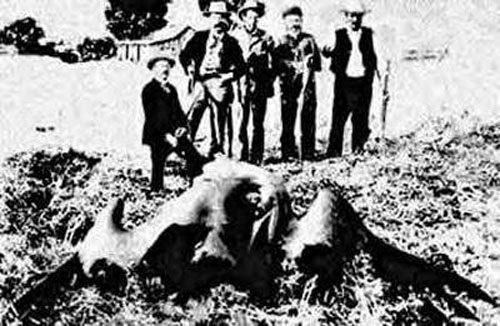
Thunderbird is a term used in cryptozoology to describe large, bird-like creatures, generally identified with the Thunderbird of Native American tradition. Similar cryptids reported in the Old World are often called Rocs. Thunderbirds are regarded by a small number of researchers as having lizard features like the extinct pterosaurs such as Pteranodon. Although reports of Thunderbird sightings go back centuries, due to the lack of scientific evidence (such as a fossil record), the creature is generally regarded as a myth.
The Thunderbird figures prominently in the traditions of many Native American tribes. For some, it is the flapping of the Thunderbird’s wings that one hears during rainstorms rumbling in the skies and it is the Thunderbird’s eyes and beak that flash the lightning. To the Lakota of the prairie, the Thunderbird is an embodiment of the Great Mystery, the Supreme Being, which created all things on Earth. For the tribes of the Iroquois Confederacy of the northeast, Hino, the Thunderbird, guardian of the skies and the spirit of thunder, could assume the form of a human when it suited its purpose. The cosmology of many of the western tribes establish a Thunderbird in each of the four corners of the world as guardians and protectors, fighting always to keep away evil spirits. Many scholars over the centuries have attributed the Native American myths of the Thunderbird to their reverence for the eagle, the largest of indigenous birds in North America. Interestingly, however, many people have claimed to have seen for themselves a great bird, far larger than the eagle, flying overhead. In fact, even in the nineteenth century, some witnesses were claiming to have seen flying monsters that resembled pterodactyls, the winged reptiles that should have been extinct 60 million years ago. On April 9, 1948, a farm family outside of Caledonia, Illinois, saw a monster bird that they all said was bigger than an airplane. In different parts of the state on the same day, a Freeport truck driver said that he, too, had seen the creature.
The Thunderbird is a legendary creature in certain North American indigenous peoples' history and culture. It's considered a "supernatural" bird of power and strength. It is especially important, and richly depicted, in the art, songs and oral histories of many Pacific Northwest Coast cultures, and is found in various forms among the peoples of the American Southwest and Great Plains. Thunderbirds were major components of the Southeastern Ceremonial Complex of American prehistory
A former army colonel admitted that he had seen a bird of tremendous size while he stood talking with the head of Western Military Academy and a farmer near Alton. On April 10, several witnesses saw the gigantic bird. One man said that he had at first believed it to be a type of plane that he had never before seen. On April 24, back at Alton, a man described it as an enormous, incredible thing, flying at about 500 feet and casting a shadow the same size as that of a Piper Cub at the same height. Two policemen said that the monster bird was as big as a small airplane. Giant Thunderbird-type creatures have continued to be sighted in various parts of the United States, from the northeast to the northwest and many points in between.
Read more at http://theunexplainedmysteries.com/Thunderbird.html
The Thunderbird figures prominently in the traditions of many Native American tribes. For some, it is the flapping of the Thunderbird’s wings that one hears during rainstorms rumbling in the skies and it is the Thunderbird’s eyes and beak that flash the lightning. To the Lakota of the prairie, the Thunderbird is an embodiment of the Great Mystery, the Supreme Being, which created all things on Earth. For the tribes of the Iroquois Confederacy of the northeast, Hino, the Thunderbird, guardian of the skies and the spirit of thunder, could assume the form of a human when it suited its purpose. The cosmology of many of the western tribes establish a Thunderbird in each of the four corners of the world as guardians and protectors, fighting always to keep away evil spirits. Many scholars over the centuries have attributed the Native American myths of the Thunderbird to their reverence for the eagle, the largest of indigenous birds in North America. Interestingly, however, many people have claimed to have seen for themselves a great bird, far larger than the eagle, flying overhead. In fact, even in the nineteenth century, some witnesses were claiming to have seen flying monsters that resembled pterodactyls, the winged reptiles that should have been extinct 60 million years ago. On April 9, 1948, a farm family outside of Caledonia, Illinois, saw a monster bird that they all said was bigger than an airplane. In different parts of the state on the same day, a Freeport truck driver said that he, too, had seen the creature.
The Thunderbird is a legendary creature in certain North American indigenous peoples' history and culture. It's considered a "supernatural" bird of power and strength. It is especially important, and richly depicted, in the art, songs and oral histories of many Pacific Northwest Coast cultures, and is found in various forms among the peoples of the American Southwest and Great Plains. Thunderbirds were major components of the Southeastern Ceremonial Complex of American prehistory
A former army colonel admitted that he had seen a bird of tremendous size while he stood talking with the head of Western Military Academy and a farmer near Alton. On April 10, several witnesses saw the gigantic bird. One man said that he had at first believed it to be a type of plane that he had never before seen. On April 24, back at Alton, a man described it as an enormous, incredible thing, flying at about 500 feet and casting a shadow the same size as that of a Piper Cub at the same height. Two policemen said that the monster bird was as big as a small airplane. Giant Thunderbird-type creatures have continued to be sighted in various parts of the United States, from the northeast to the northwest and many points in between.
Read more at http://theunexplainedmysteries.com/Thunderbird.html
Tuesday, August 31, 2010
Unsolved Mysteries of World - Bimini Road

| Bimini is an island in the Bahamas, 55 miles east of Miami, Florida, approximately 7 miles long and 1/3 mile across at its widest point. Its modern inhabitants are descendants of West African slaves imported by Spain and Britain beginning in the mid-16th century. They replaced the resident Caribs, who arrived only a few generations before and after whom the Caribbean Sea was named. Bellicose cannibals from Middle America’s mainland, the Caribs feasted on the island’s earliest known inhabitants, the Lucayans, a linguistic branch of Arawak Indians. Before their extermination (consumption?), the Lucayans were described by Spanish explorers as able craftsmen (surviving Lucayan celts and hammer-stones attest to their refined skills), with noticeably lighter complexions and auburn hair, even occasional blue eyes. These untypical traits may have been genetic traces of contacts with pre-Columbian visitors from Europe, or even racial evidence for an Atlantis pedigree, in view of the following information. The origin and meaning of “Bimini” are unknown. However, the name appears in the Ancient Egyptian language as Baminini, which means, “Homage (ini) to the Soul (ba) of Min.” Min was the Egyptians’ divine protector of travelers on far-off journeys, a particularly appropriate god to be worshiped at distant Bimini, if indeed the island had been visited by voyagers from the Nile Valley. Material evidence for an Egyptian or, at any rate, an Egyptian-like presence in the western Atlantic appeared during the late 1930s, when James Lockwood, Jr., an American archaeologist in Haiti, saw a stone statue of the ancient Egyptian god of the dead, Anubis, that had been discovered on an off-shore island. The Lucayans knew Bimini as “Guanahani,” another curious connection with the Ancient World, because the name translates as “the Island (hani) of Men (guana)” in the language of the Guanches. These were native inhabitants of the Canary Islands, off the northwest coast of North Africa, until their utter demise at the hands of the Spanish in the 15th and 16th centuries. Although no monumental buildings were found on Bimini, in Arawak, Guanahani meant “the Place of the Encircling Walls”; in Arawak, hani was also synonymous for “crown” or “wreath.” This oldest known name for the island may have referred to a large stone formation lying in 19 feet of water less than 2 miles off Bimini’s northernmost point. It is composed of so far unnumbered but certainly no less than 5,000, mostly square-cut blocks running in a straight line for about 1,900 feet, before swinging back on itself to create a J-formation. To early observers, it resembled a paved road running across the bottom of the sea. But the general consensus of investigators since then tentatively identifies the structure as a cyclopean wall, not unlike Andean examples found in Peru, specifically, at Cuzco and Sacsahuaman.  Unfortunately, it continues to be known by its first and misleading appellation. In 1933, Edgar Cayce, during one of his trance states, said that records from Atlantis still existed “where a portion of the temples may yet be discovered, under the slime of ages of sea water—near what is known as Bimini.” The little island was not Atlantis itself, he explained, but its outpost, known many thousands of years ago as Alta, extending (politically) to east-coastal Florida, and part of a wider Atlantean administration known as Poseidia, comprising the Lesser Antilles. In 1940, the “Sleeping Prophet” predicted, “Poseidia will be among the first portion of Atlantis to rise again. Expect it in ’68 and ’69; not so far away!” The so-called “Bimini Road” was, in fact, “discovered” in 1968 by maverick archaeologist Mason Valentine, while looking for Atlantean remains around the island in hopes of confirming Cayce’s prophesy. .Read more at Unsolved Mysteries of World |
Subscribe to:
Comments (Atom)


